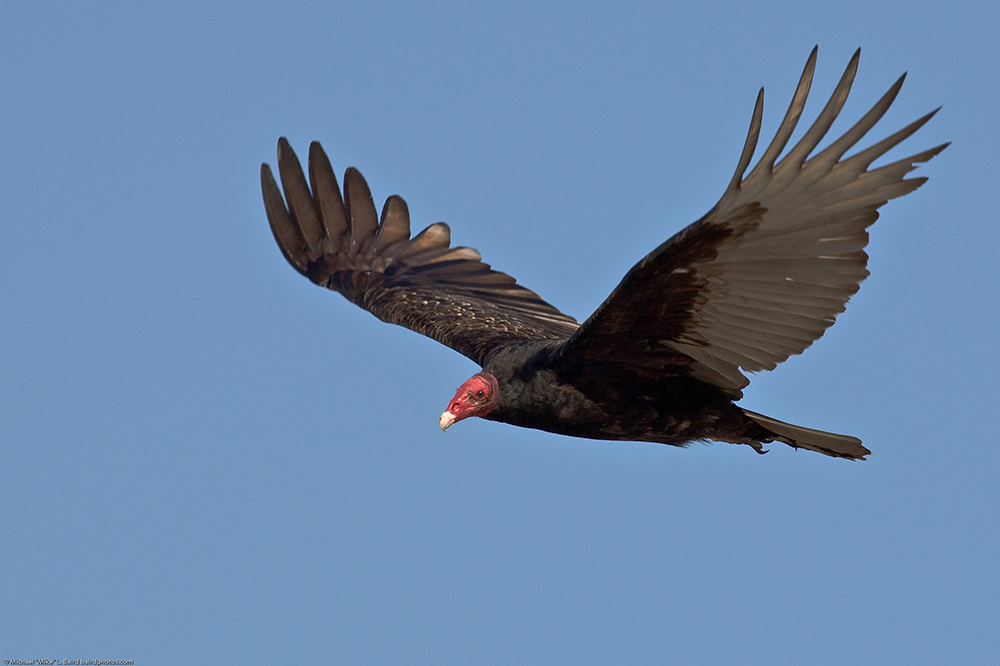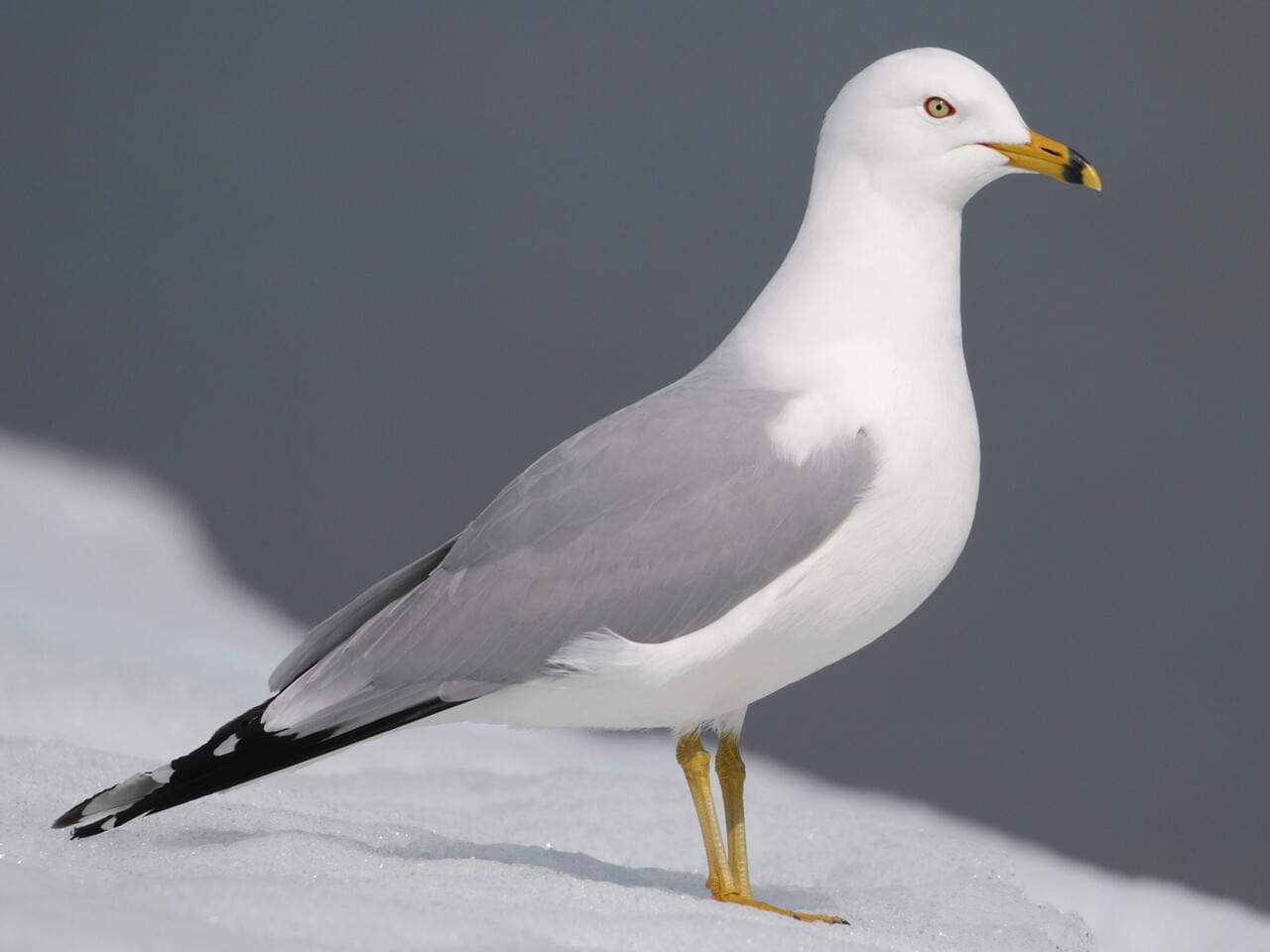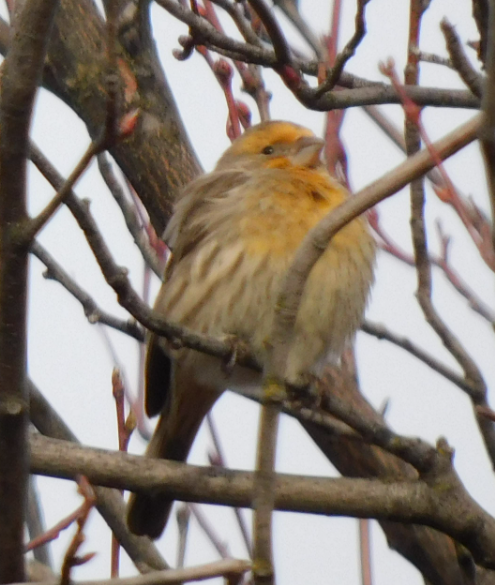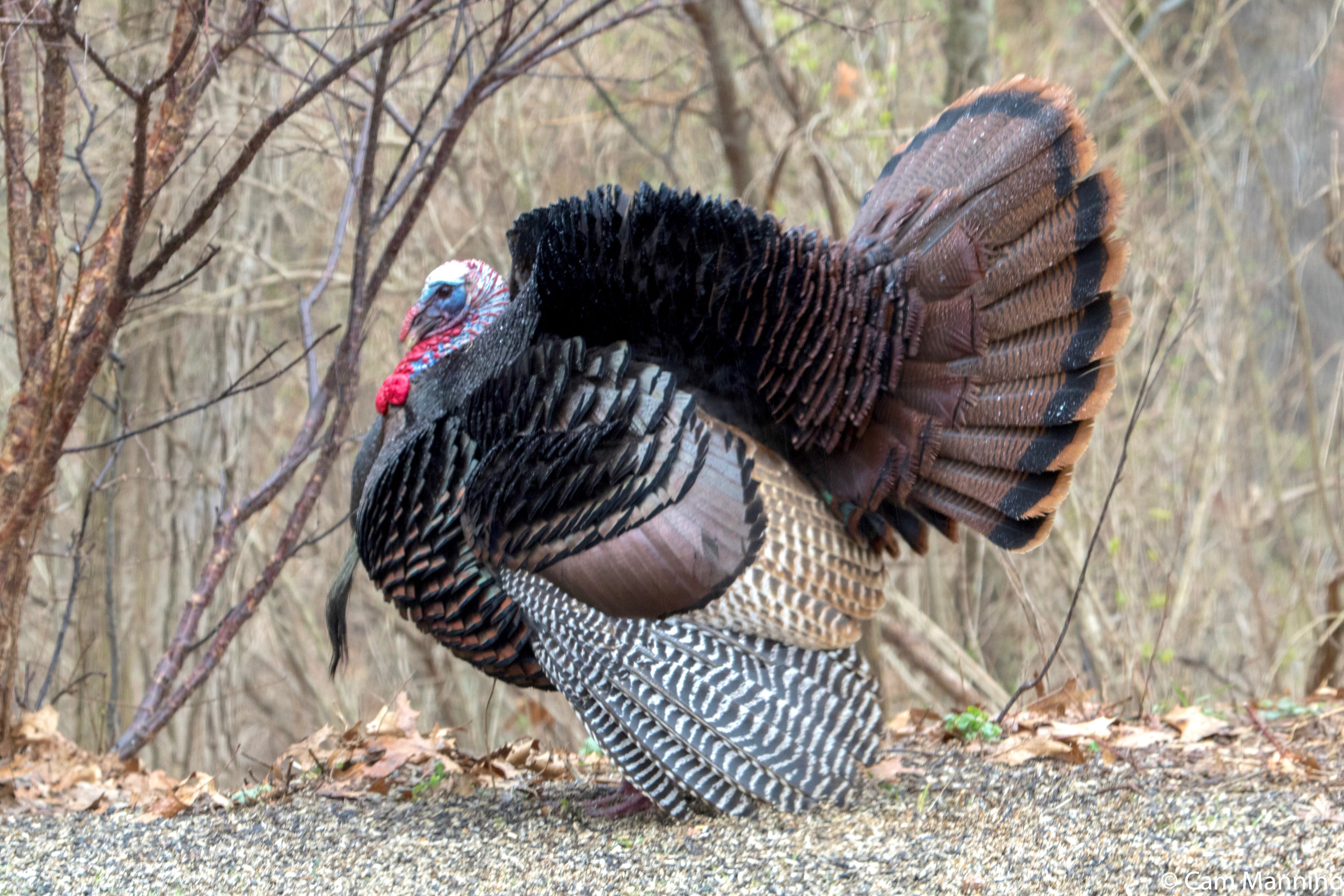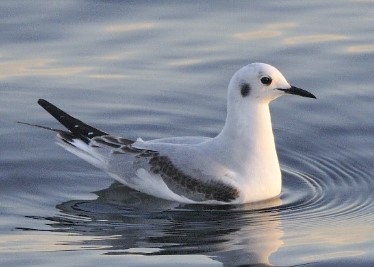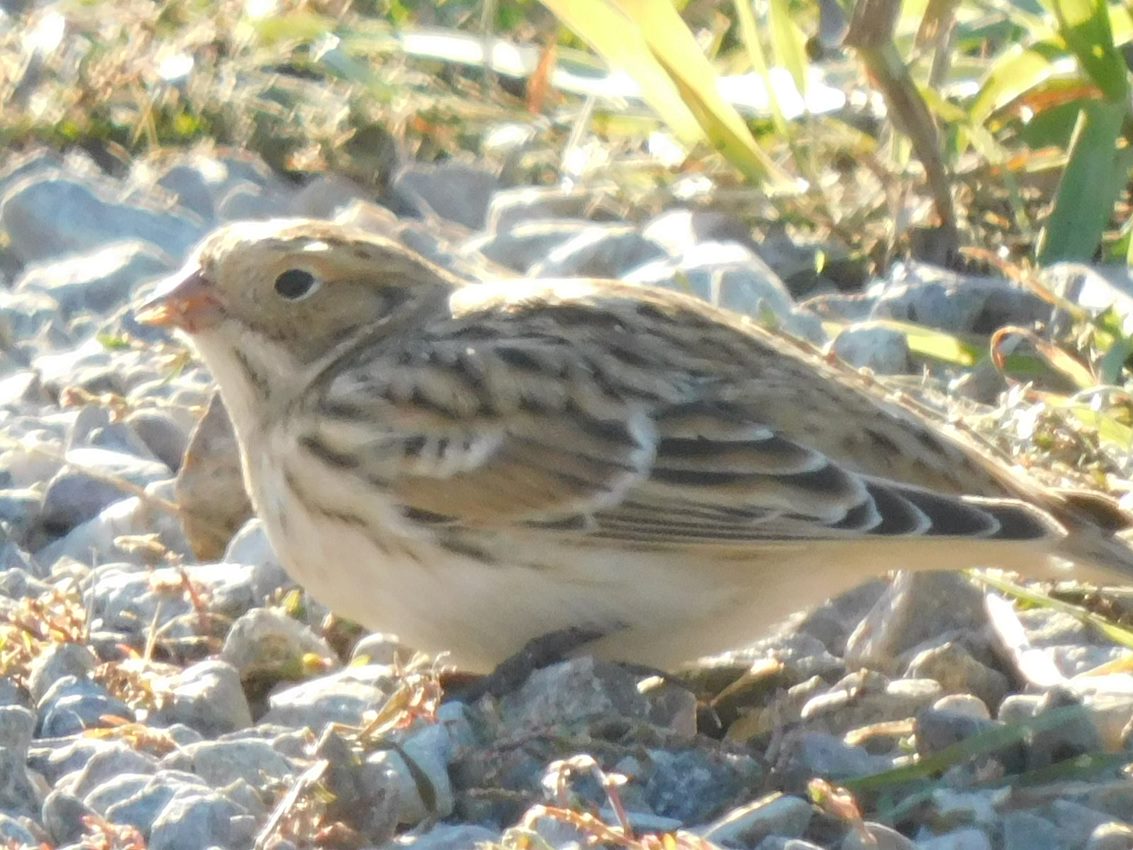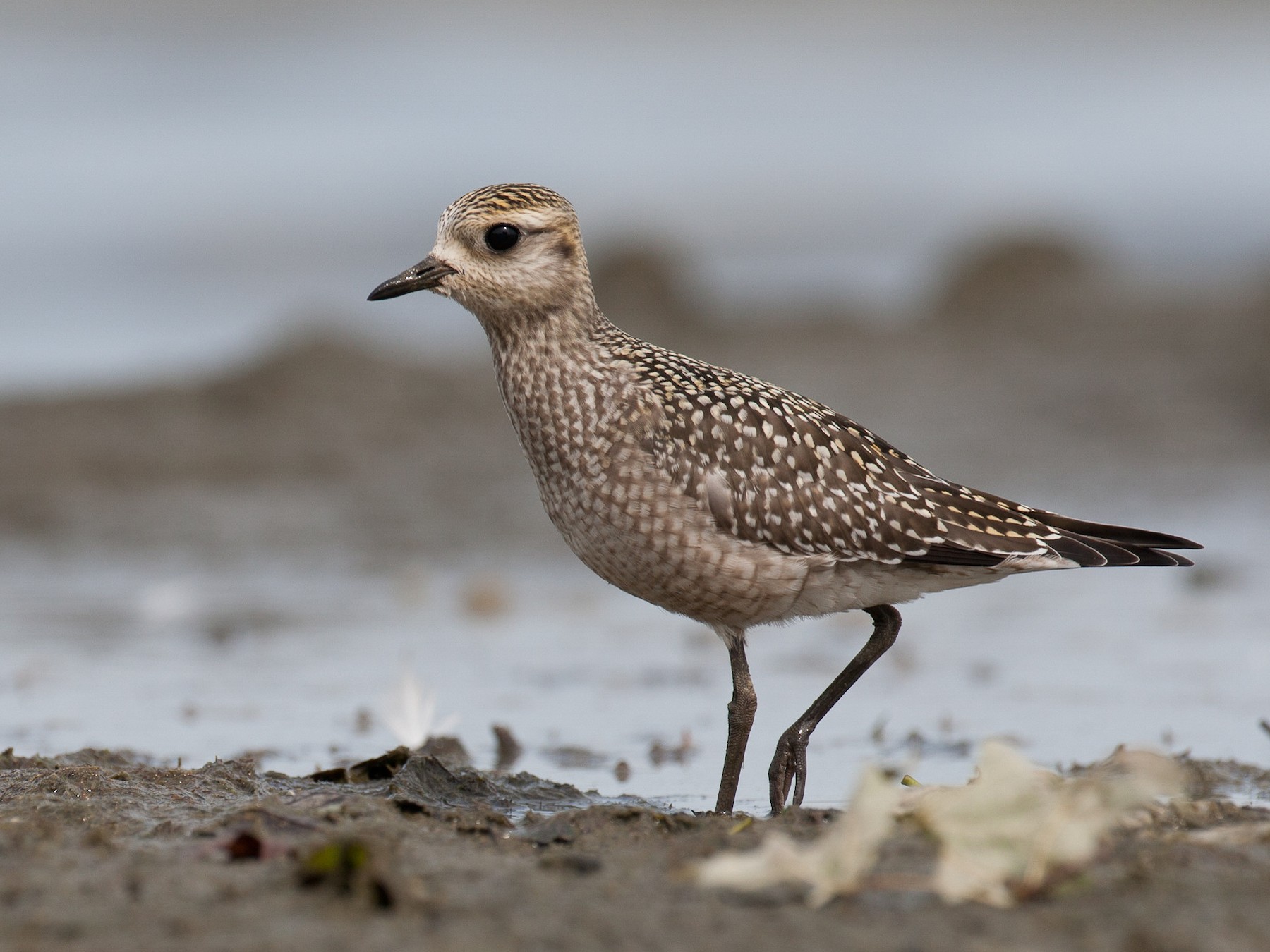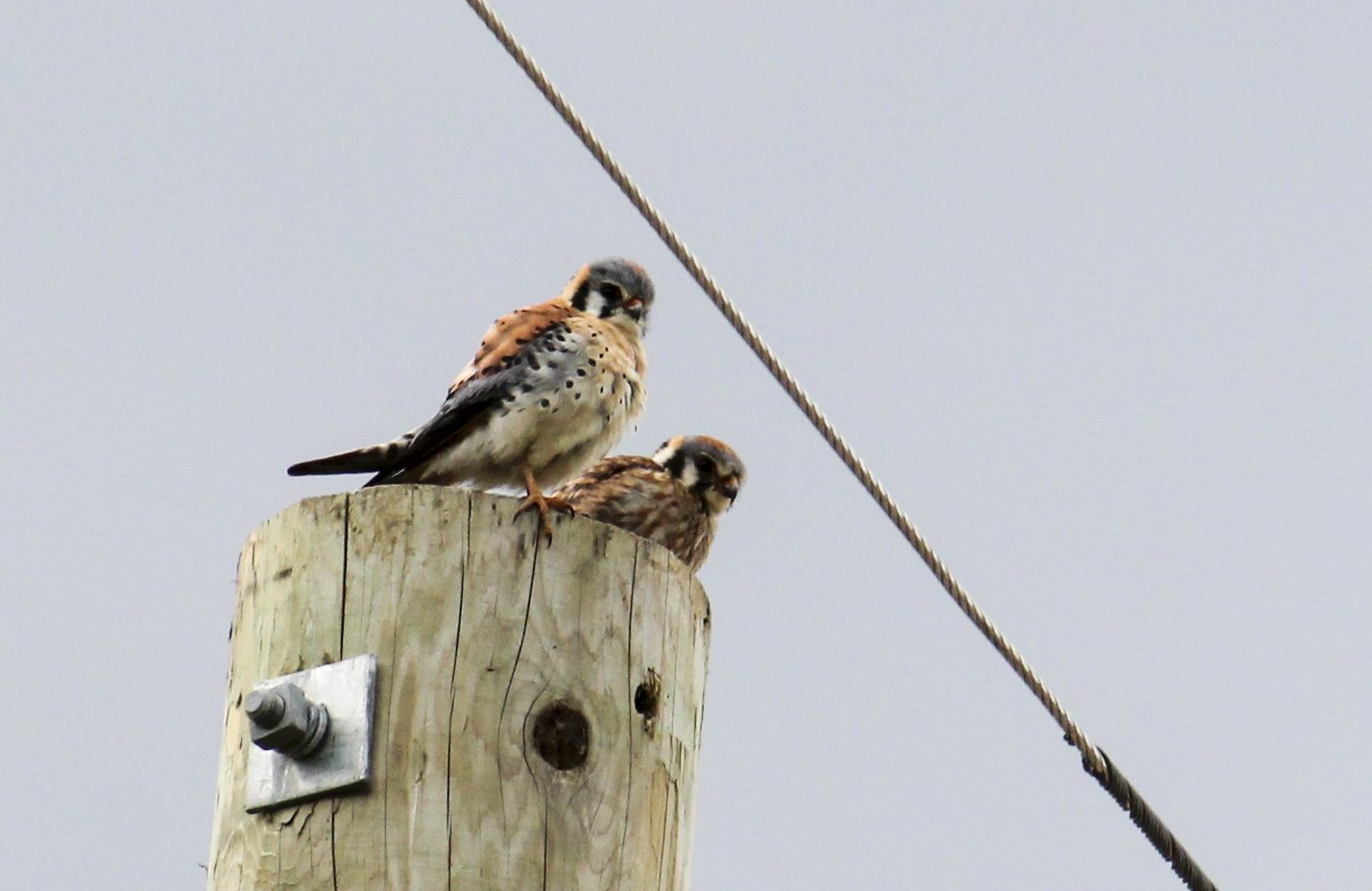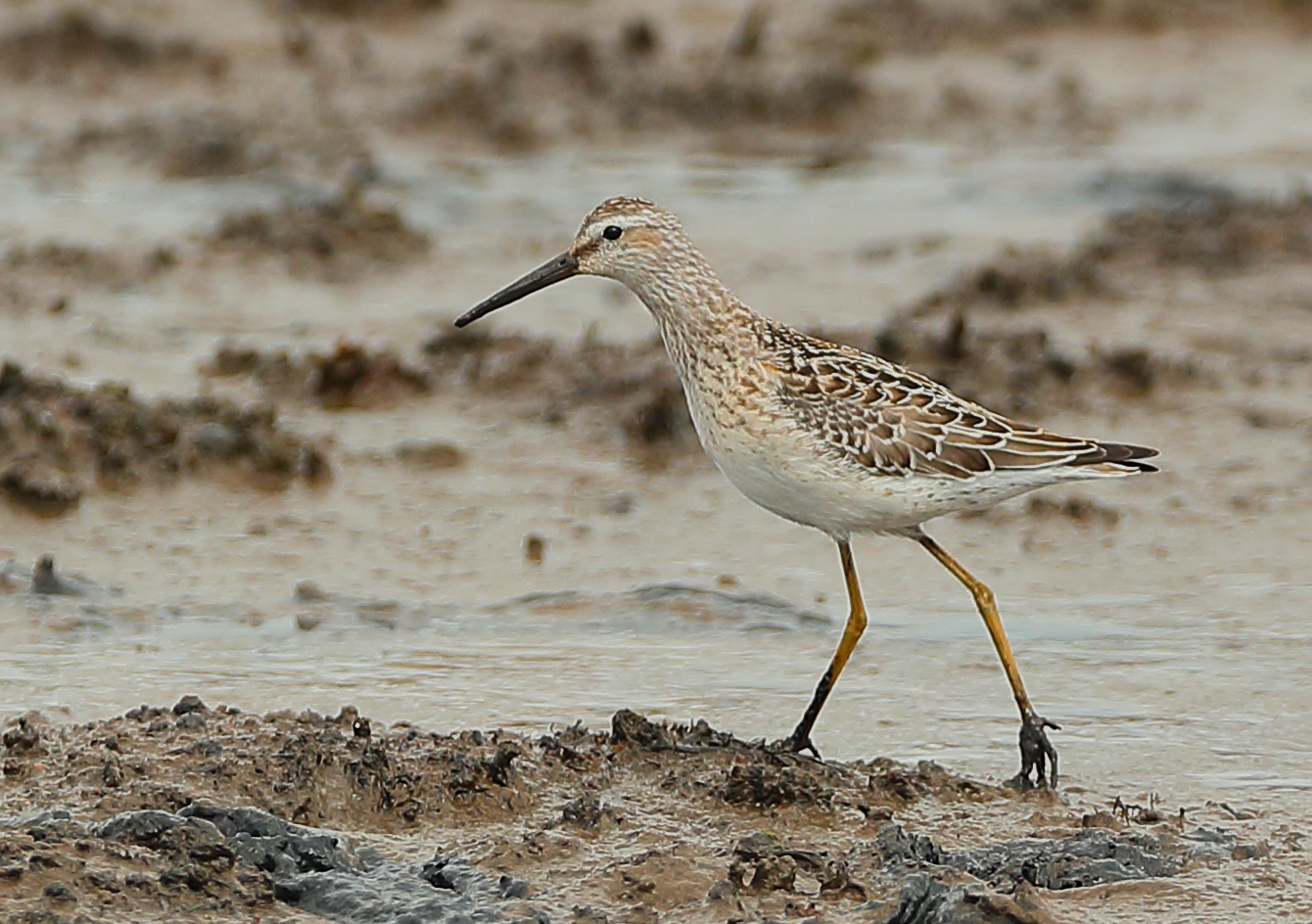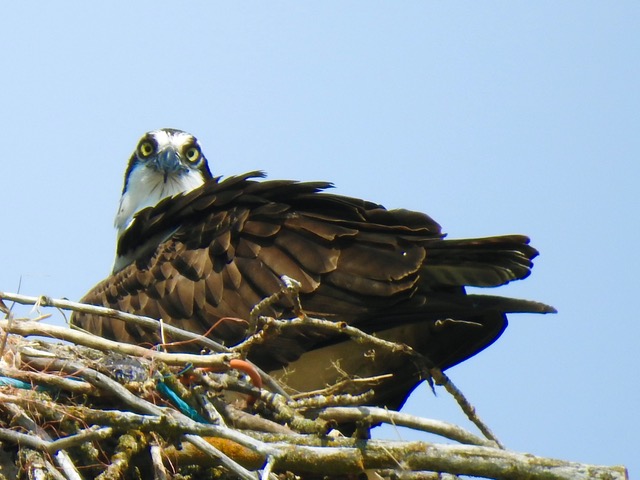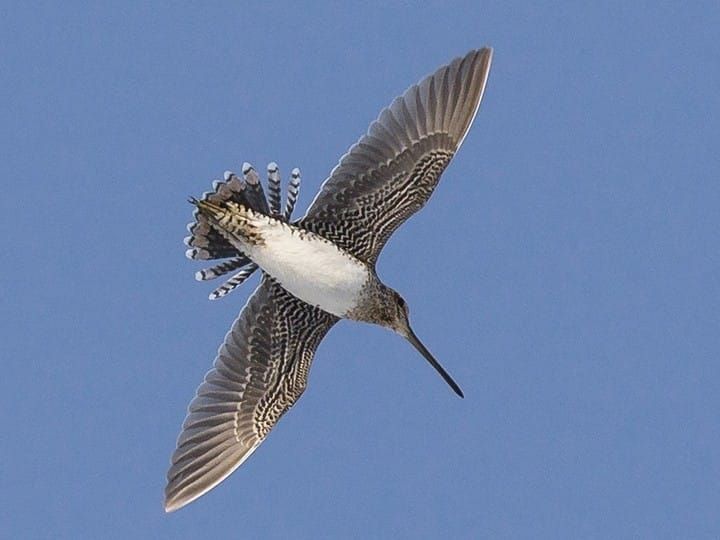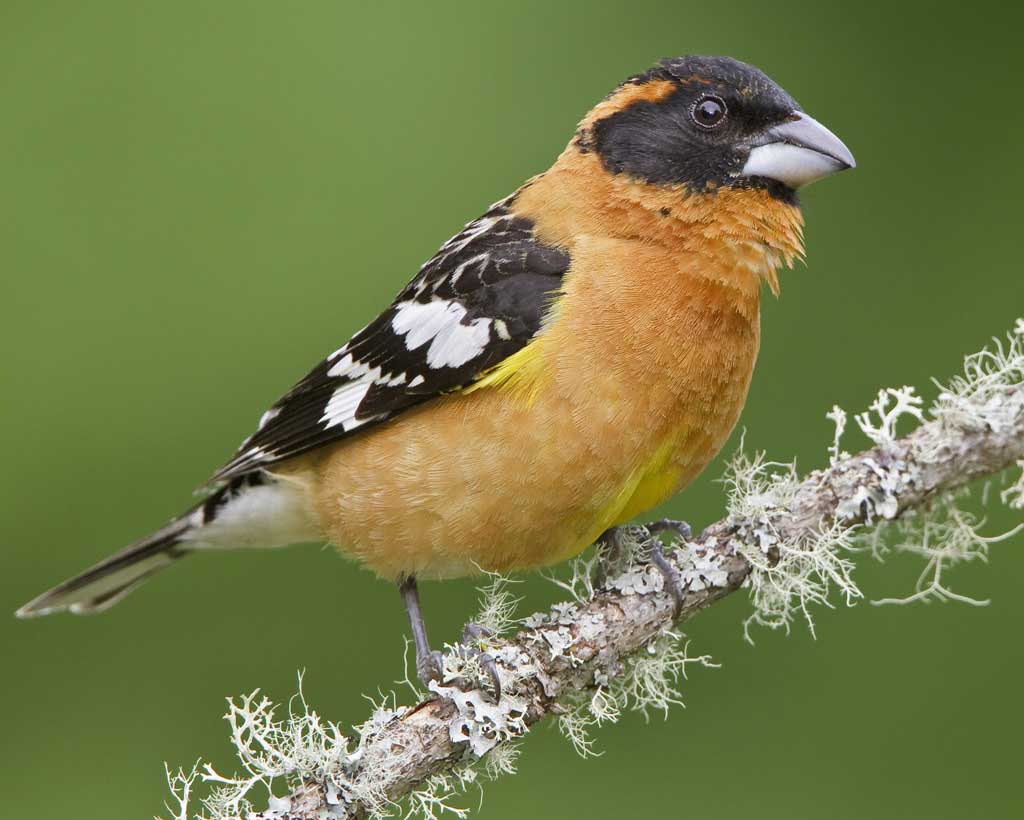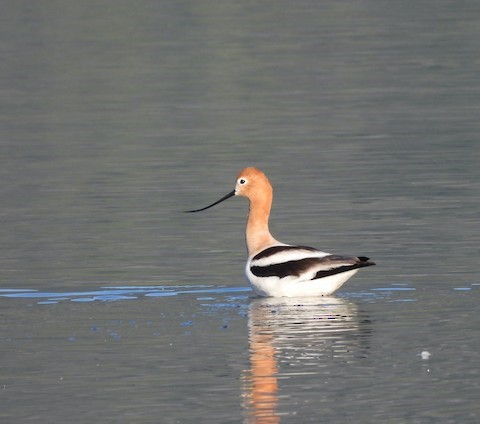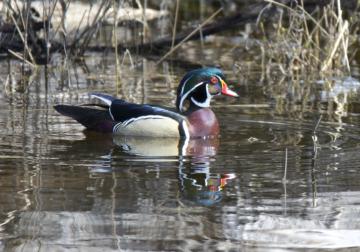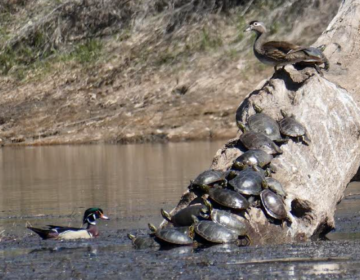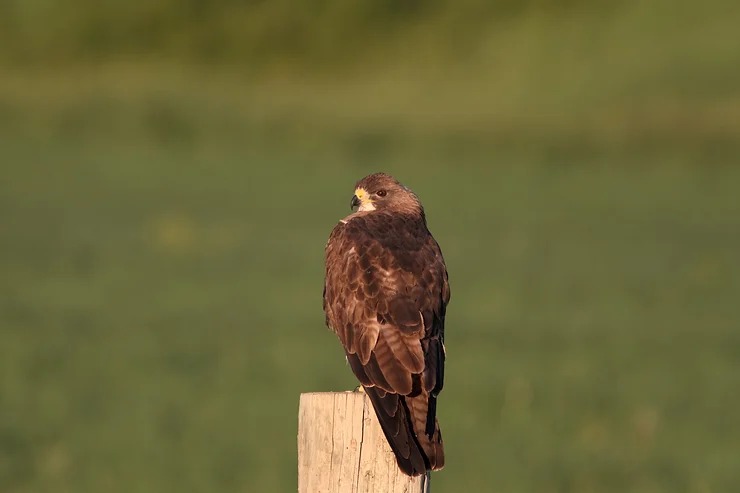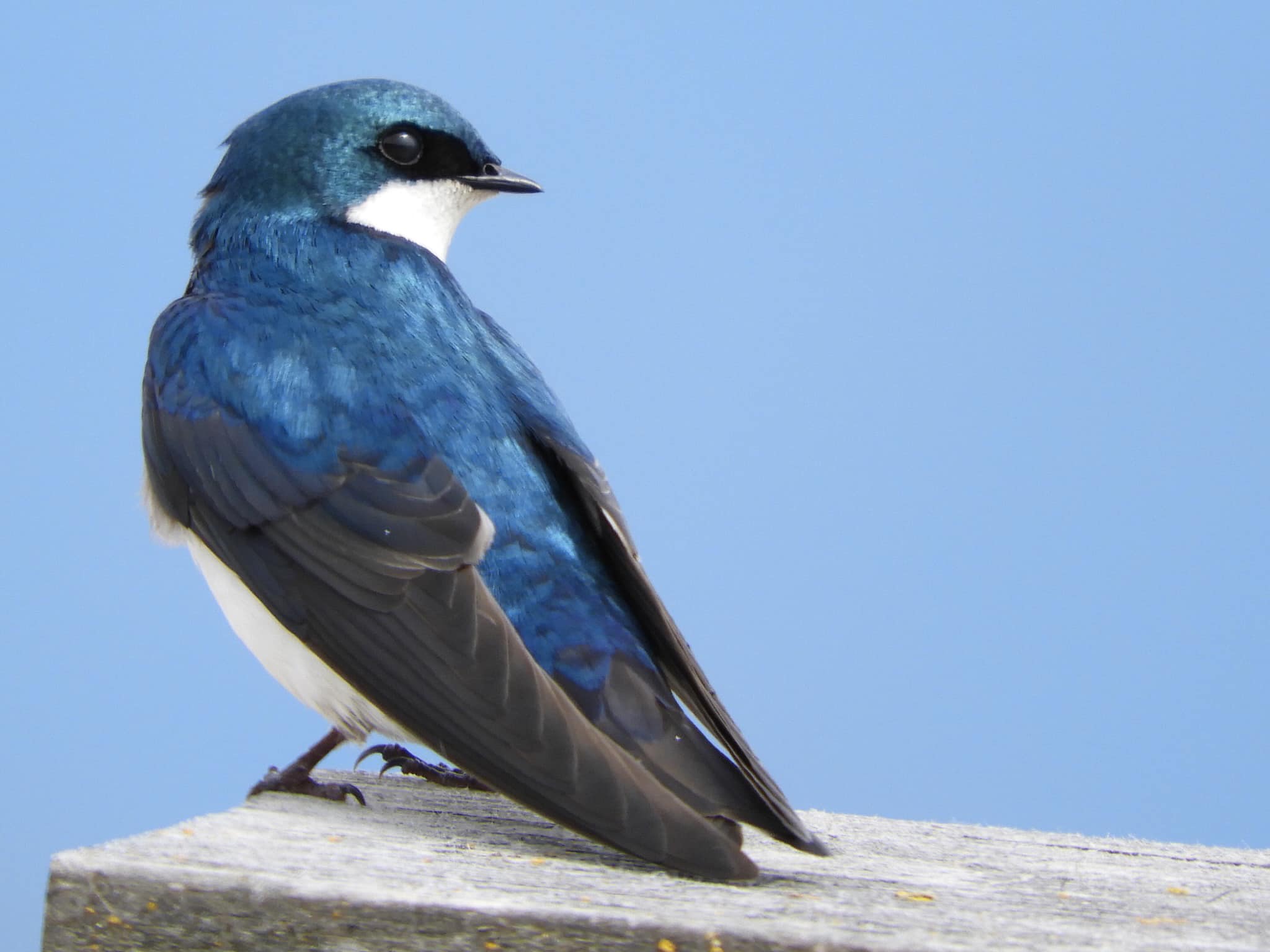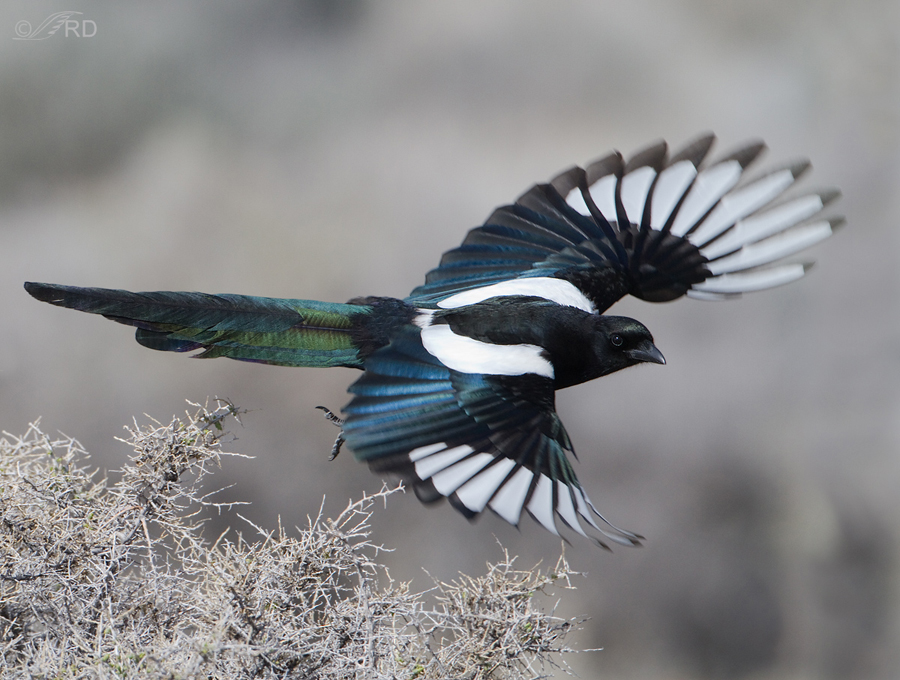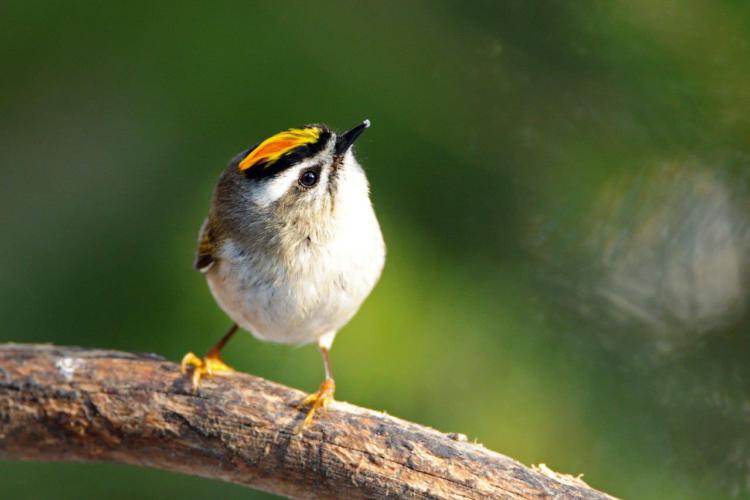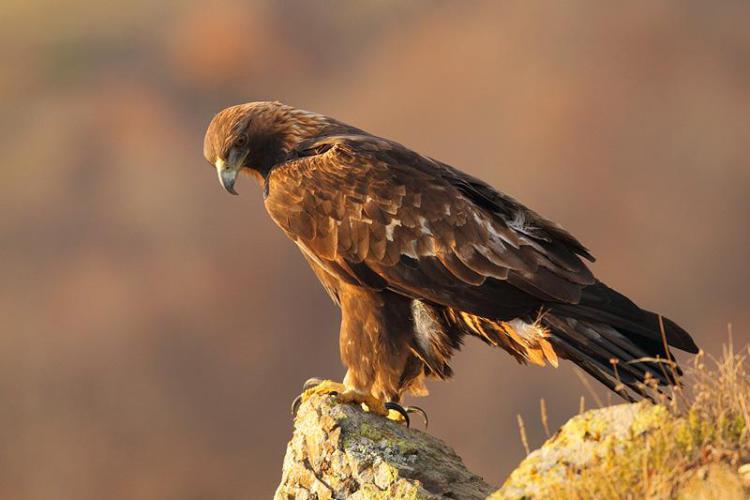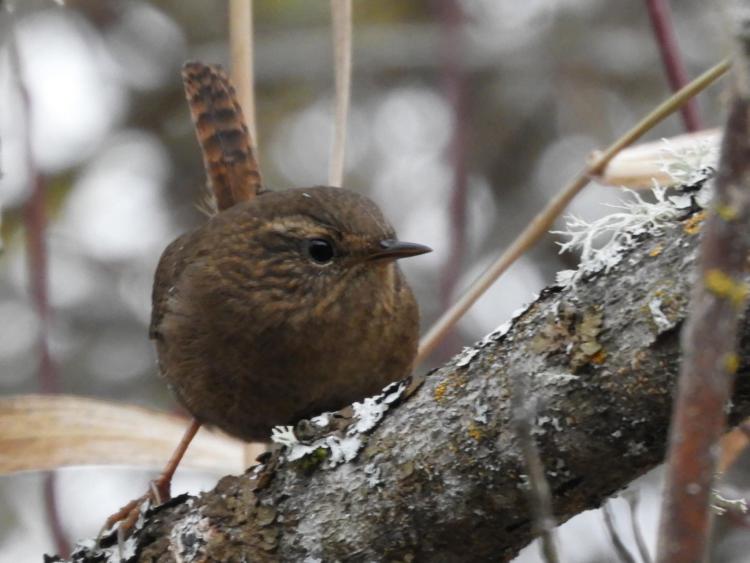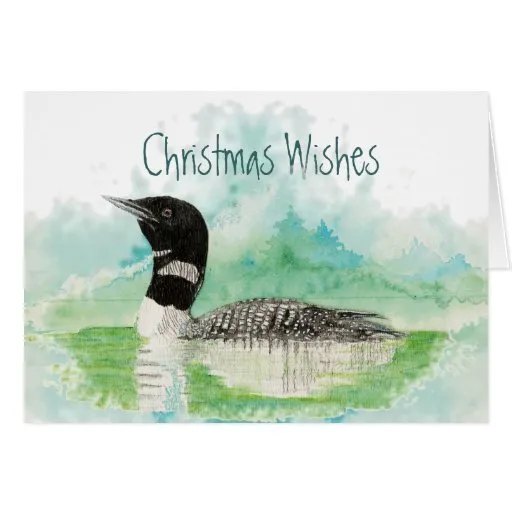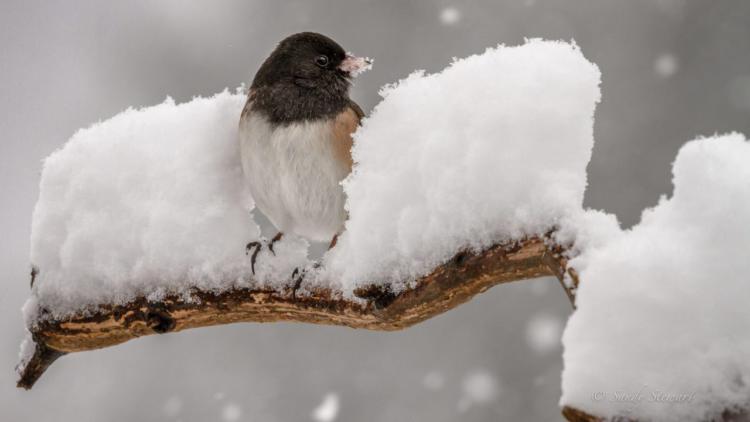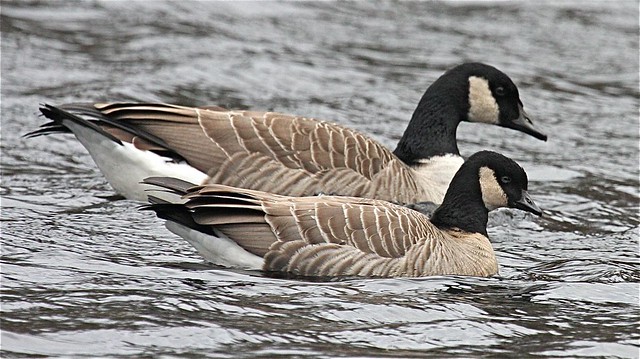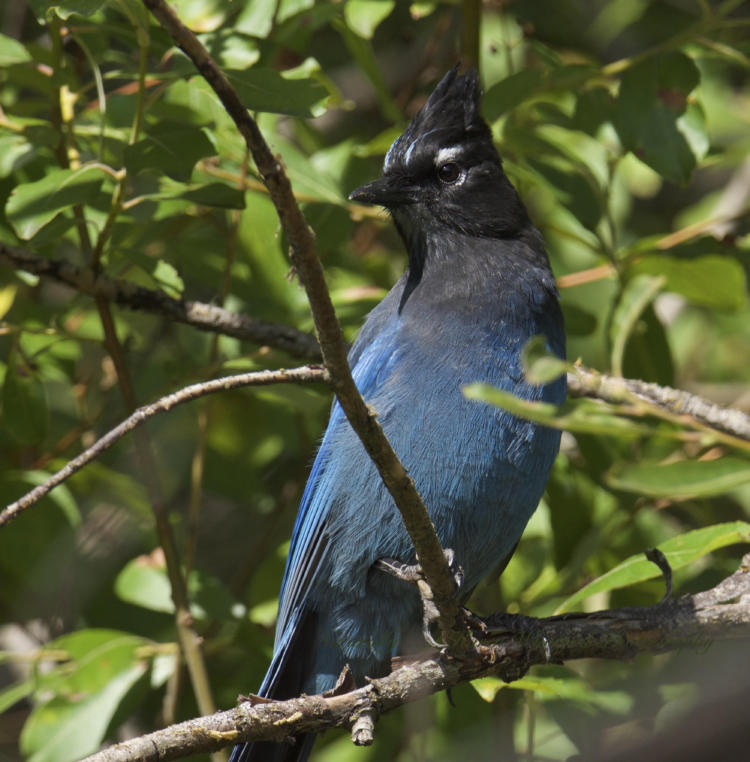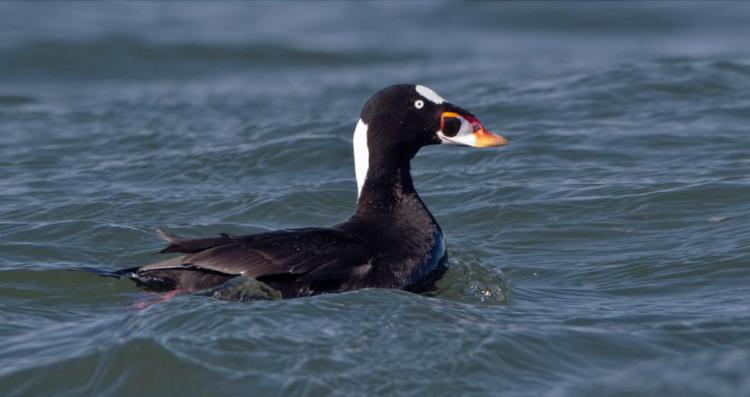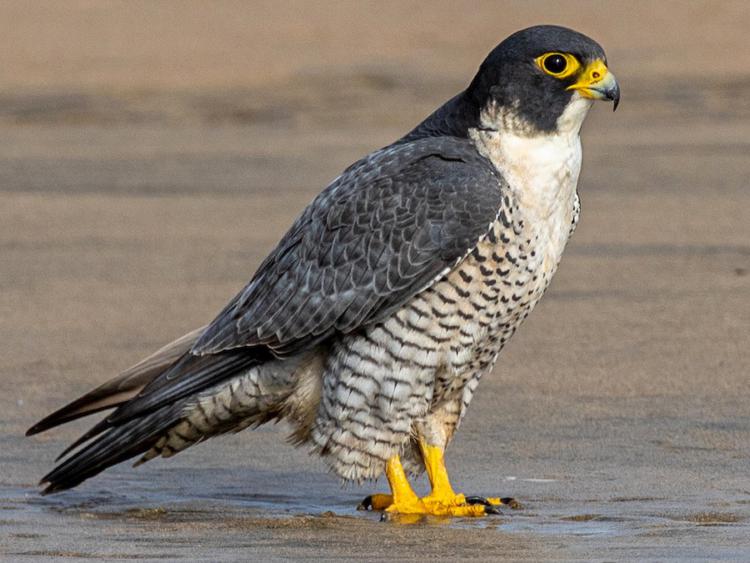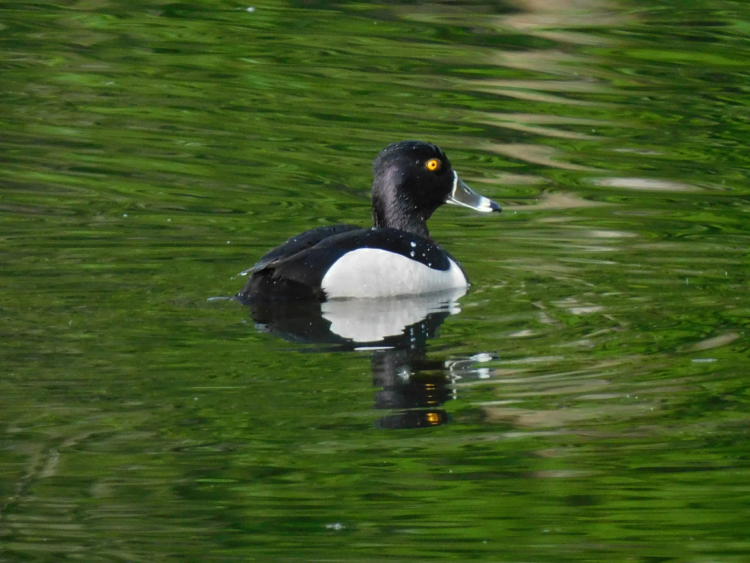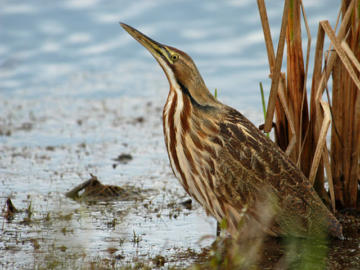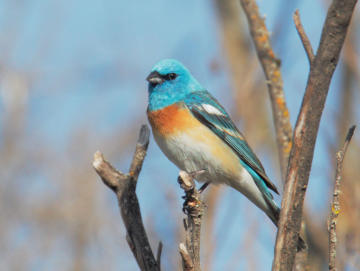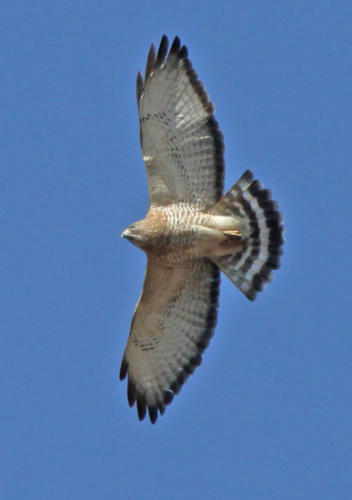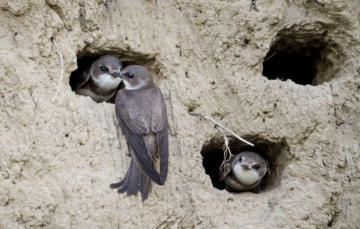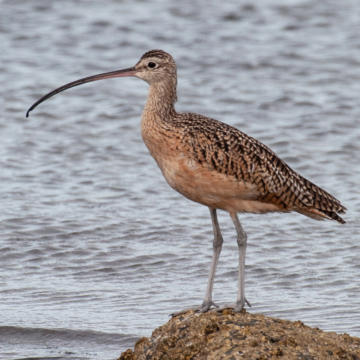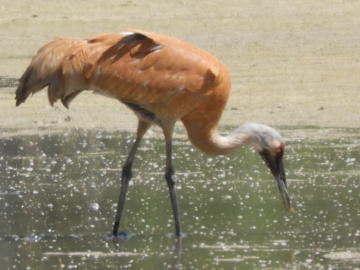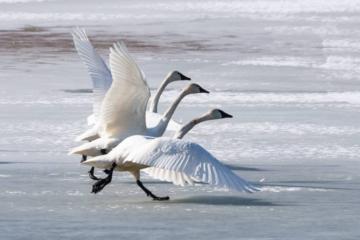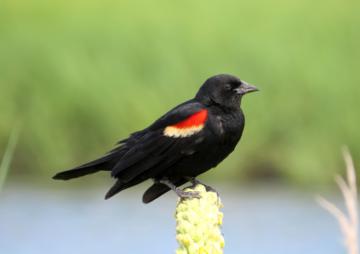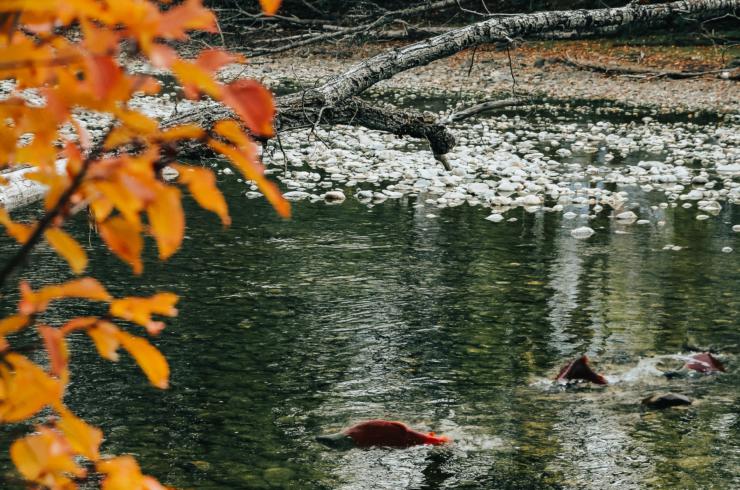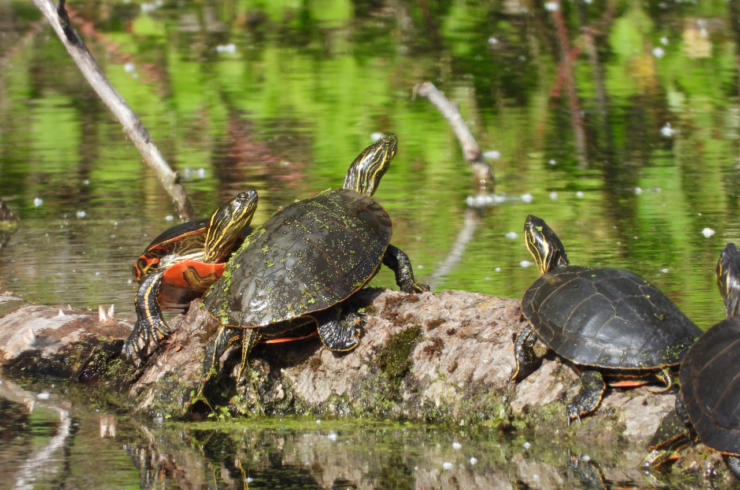April 14, 2024
NORTHERN SHOVELERS forage in our shallow wetlands, flooded fields, and lakes. I saw a few on the south shore of Kootenay Lake yesterday while in my kayak!
Their large shovel-shaped bill sets it apart from other dabbling ducks. When viewing way out in the water, look for the pumpkin-colored flanks surrounded by a white chest and white lower sides. Female shovelers are mottled in brown and their very large orange bill is their most notable field mark.
April 7, 2024
TURKEY VULTURES are on the move! Spring migrants generally arrive this time of the year. They are mostly seen soaring high in the sky searching for carrion with their keen sense of smell.
As it’s soaring, look for it’s pronounced dihedral wings (lifts them high), small head, and the two-toned black underwing. Adults have a red head that is bare. Juveniles sport a black head.
March 24, 2024
Have you seen your first AMERICAN ROBIN this spring yet? Although this species symbolizes spring for most people, it is actually found in the Creston Valley year-round. There is a noticeable influx of birds at this time of the year when migrant flocks are passing through.
This species is one of our most familiar birds and commonly seen on lawns looking for worms and insects. The song is a pattern of warbled phrases, followed by a pause and then another set of phrases.
March 17, 2024
The sounds of spring are in the air! The song of the SONG SPARROW begins with several short, sharp notes followed by one long trill with different tempos and quality.
https://www.allaboutbirds.org/guide/Song_Sparrow/sounds
Identified easily by the broad brown streaks and a messy central breast-spot, this sparrow is a common species found throughout our valley year-round. During this spring migration time, their numbers increase bringing us music everywhere!
Photo credit: Tammy Bradford
March 10, 2024
A few people this week have spotted a very rare YELLOW-BILLED LOON!!! It was seen in the Balfour area as well as at the Kuskanook Harbour in its winter plumage (not as striking as this photo).
It was described by Sachi Snively as “Big pale smudgy winter plumage loon with three winter plumage Common Loons on the Balfour end of Queens Bay. Bulky neck, head with prominent bumps both fore and aft, yellow culmen with yellow/pale lower mandible giving the appearance of the bill being upturned and overly long.”
March 3, 2024
Another species found in the higher elevations of coniferous forests is the BLACK-BACKED WOODPECKER. Good places to check is along the Lakeview-Arrowcreek and Dodge Creek forest roads, the summit, and possibly in some forest burns. They like to forage on dead trees especially the trunks. They spend long periods in a single spot to excavate beetle larvae from deep inside the tree.
This larger woodpecker has an all-black back with a bluish gloss. The males and juveniles of both sexes have a yellow crown but the adult female’s is all black. Also note the white cheek strip on its face and the tiny white dot behind the eye! The fine black barring on the flanks is often smudged gray from soot in burned habitats.
February 25, 2024
The CANADA JAY is also a species that lives in higher elevations and prefers mixed evergreen-deciduous forest (especially spruce) all across Canada.
In the late winter, they will incubate eggs in temperatures that may drop below minus 20°F and will rear chicks in the dark of winter.
In 2018, the American Ornithological Society voted to change the common name of the Gray Jay to Canada Jay. Dr. David Bird is still trying to make the Canada Jay our National Bird. They have also been known as “Whisky Jacks” and “Camp Robbers”!
Dr. David Bird talks about the Canada Jay

February 18, 2024
CLARK’S NUTCRACKER are found up in higher elevations where they love conifer seeds especially from Ponderosa and Whitebark pines. The best places to possibly see them are up Thompson Mountain or the Summit.
With their dagger-like bills they can rip into pine cones to pull out large seeds, which it stores in a pouch under their tongue and then carry away to bury for the winter. Each birds buries thousands of seeds and, remarkedly, can remember the locations of most of them months later and under the snow! Seeds they don’t retrieve play a crucial role in growing new pine forests (sourced from All About Birds).
February 11, 2024
Northern Saw-whet Owls are heard more often than seen and late winter-spring is their active calling period. Listen for a distinctive “too-too-too” song, an insistent series of whistled notes on roughly the same pitch, given at a rate of about 2 notes per second. Males calling to advertise their territory can be heard up to half a mile away. Northern Saw-whet Owl sounds
These owls will use woodpecker holes or natural crevices but can also be found roosting in barns, hay sheds, chicken coops, and stables (sourced from Linda Van Damme, 2020).

February 4, 2024
Three species of gulls have been seen at the south end of Kootenay Lake recently.
RING-BILLED GULLS have a black band across their yellow bill, yellow legs, and a pale gray back.
HERRING GULLS are larger with a red spot on the lower bill, pink legs, and a pale eye.
CALIFORNIA GULLS also have a red spot on the lower bill but they have a dark eye.
Ring-billed Gulls are comfortable around humans and are most likely what you are seeing but look a little closer next time in case you are spotting a different species of gull! Many people just call them “seagulls.” In fact, some two dozen different species of gulls live in North America.
January 27, 2024
EURASIAN-COLLARED DOVES can be found anywhere around human environments – at bird feeders, with livestock, in farmyards, in crop fields, or just sitting on wires coo-cooing!
They are a non-native species recently (2008) arriving in Creston. This species was introduced from Asia to the Bahamas in the 70’s when some birds escaped into Florida and now are rapidly spreading across NA (sourced from Linda Van Damme 2020).
There is a healthy population on Kootenay-River Road around the farmlands.
January 21, 2024
A very rare species found here in the wintertime is a RUSTY BLACKBIRD!! Three birds were sighted by Marc-Andre Beaucher on Nicks Island Road yesterday by the cattle feeders. The male was in breeding plumage – dark glossy black with a greenish sheen.
A sharp eye is needed as this bird could easily go undetected in large flocks of other blackbirds and starlings that frequent beef and dairy farms (sourced from Van Damme 2020).
January 7, 2024
Every winter, American Coots feed at the south end of Kootenay Lake and are hunted by BALD EAGLES.
Other feeding opportunities:
In the springtime, these eagles go back to eating fish that are ice-trapped in water bodies such as Duck Lake. Bald eagles can also be easily seen on treetops surrounding lakes as they hunt ducks. And they can be seen around cattle farms during calving seasons to feed on the afterbirth. It will also scavenge along highways for road kills (sourced from Linda Van Damme 2020).
Photo credit: Ulrike Sliworsky
December 31, 2023
A yellow variant HOUSE FINCH was found on Crawford Hill during the Christmas Bird Count on December 27th.
Colors of a House Finch can range from a pale straw-yellow through to bright orange to deep, intense red!
The yellow coloration is caused by a combination of genetic (a gene known as “Goldschmidt’s Yellow”) and dietary factors. These birds could be feeding on high-carotenoid fruits of ornamental plants giving them an overall yellowish hue on their feathers, beaks, and eyes.
Photo credit: Ulrike Sliworsky
December 24, 2023
With so many turkeys going into the oven tomorrow, it seemed appropriate to feature the WILD TURKEY that roams our valley!
Wild Turkeys likely showed up in the Creston Valley during the 60’s after they crossed the international border from Washington. They are actually domesticated birds native to the New World.
Flocks can be found throughout most of the valley including within the townsite where they have become a nuisance by damaging gardens, yards, and birdfeeders. They favor open forests, agricultural fields, cattle pens and pastures, rural properties near wooded areas, and they are also attracted to manure piles (Linda Van Damme 2020).
Has anyone tried eating one??
Merry Christmas!!
December 17, 2023
A BONAPARTE”S GULL in its first winter plumage was spotted this week at Duck Lake. This species is a small tern-like with pointed wings. Look for the dark ear-spot and black bill. The head will turn into a black hood as it matures.
Fall migration in the Creston valley occurs from late September to late November so this bird was a late migrant. There are a few winter records for this species but it is rare to see them this time of year.
December 10, 2023
The red-shafted NORTHERN FLICKER is a common resident of Creston and can be seen around town all winter.
This species can be seen everywhere! Feeding seed and suet in feeders, eating berries off trees, digging for insects and banging on eaves troughs, and I have even heard of them going down chimneys in search of food! They are a very versatile species and the most common woodpecker in our valley.
December 3, 2023
Although its starting to freeze up outside, you can still find some REDHEAD ducks where there is open water on Duck Lake or the south end of Kootenay Lake.
During the fall migration they pass through here by the thousands. Overwintering birds rely on access to feeding and resting areas during winter conditions.
With an obvious red head, it is also recognized by being very round overall – rounded back, puffy, and a round head. Females are a brownish-tawny color.
November 26, 2023
A few weeks ago I found 3 LAPLAND LONGSPURS foraging for plant seeds along the dyke road at Duck Lake. This species is a rare to very rare autumn transient that likely goes undetected during its migration as they feed on the ground, concealed by vegetation (Linda Van Damme, 2020).
Photo credit: Ulrike Sliworsky
November 19, 2023
A flock of COMMON REDPOLLS have been foraging on tansy seeds along the Duck Lake dike road as well as the Kootenay River Road. They are an irruptive species, not always present every year. Sometimes there are Pine Siskins and Snow Buntings mixed in! Last week a Hoary Redpoll was seen within the group.
Redpolls are fluffy, small, brown-streaked finches with tiny yellow bills, dark lores, and red forecrowns (David Sibley, 2000)
November 12, 2023
This week there have been a few sightings of an immature female BLACK SCOTER at Duck Lake. She has been described as having pale cheeks and a dark cap.
This species is often found in mixed flocks with large numbers migrating along the coast. In the Creston Valley this is a casual sighting which means less than 6 documented records.
November 4, 2023
A large flock of GRAY-CROWNED ROSY FINCHES have been seen recently in the Castlegar area so they could be found in our valley right now too!
They frequent alpine and subalpine areas so look for them near the Mount Thompson Forest Service Road or on a steep slope above Topaz Creek Forest Service Road (sourced from Linda Van Damme 2020). I have seen them foraging on the cliffs along Highway 21.
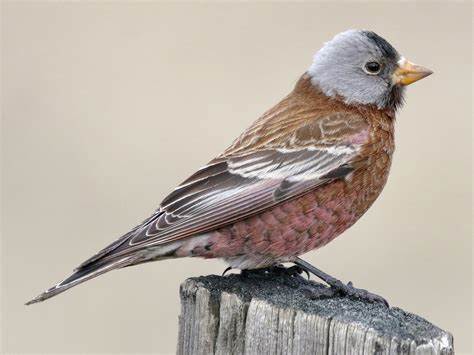
October 29, 2023
A rare autumn sighting is a WHITE-BREASTED NUTHATCH that has been seen near Lister Park in the last couple of weeks. They are attracted to feeders with suet and black sunflower seeds. These birds often climb head down a tree to feed on insects or hidden seeds that they place in bark crevices.
Larger than a Red-breasted Nuthatch, they can be found in open woods with mature trees where its nasal calls are heard frequently.
September 24, 2023
On September 18, 2023 there was a sighting of an AMERICAN GOLDEN PLOVER at the south end of Kootenay Lake. There has only been one other documented recording in the Creston valley on September 15, 1985 (sourced by Linda Van Damme 2020). This species was well outside its normal migratory range!! It usually migrates along our coast or the prairies.
September 5, 2023
There are a lot of AMERICAN KESTRELS flying around right now. I found 9 on the Kootenay River Road Sunday, September 3rd. Also a lot of sightings in the Lister area.
August 13, 2023
A small flock of STILT SANDPIPERS appeared at Leach Lake this week. There have only been 3 other documented records of this species in our valley so it’s very special to find one!
This species likes to wade in sheltered, muddy pools with their long yellow legs. They have a heavy, slightly drooping bill and a white line above the eyes.
July 9, 2023
A very rare migrant to the Creston Valley is the YELLOW-BREASTED CHAT. There has been a singing male near the Balancing Rock parking lot. He is recognized by a large repertoire of songs made up of whistles, cackles, mews, catcalls, caw notes, chuckles, rattles, squawks, gurgles, and pops, which they repeat and string together with great variety. They sing in morning and evening, either concealed in thickets or exposed on prominent perches within their breeding territories (All About Birds, the Cornell Lab).
It was once a member of the New World warbler family, but in 2017, the American Ornithological Society moved it to its own family Icteriidae. It is larger than any other wood-warbler with a thick bill, white “spectacles”, and a very bright yellow throat and breast.
July 2, 2023
COMMON NIGHTHAWKS are seen mostly in the evening flying over woods, fields, or towns catching insects. I heard one in my backyard the other night but they have also been seen up by Twin Bays beach lately.
The white bar near the base of the primaries is very distinctive as they fly erratically with deep wingbeats and glide on raised wings.
Common Nighthawks breed in drier coniferous forests of our valley. Eggs are laid on the ground amongst dry leaves, fallen needles, mosses, lichens, or even bare rock. Chicks spend their time on the ground camouflaged against predators (sourced from Linda Van Damme 2020).
June 25, 2023
There have been a lot of PACIFIC-SLOPED FLYCATCHER calls heard around the valley lately. The male gives a very high, thin whistle note. Flycatchers are very difficult to identify using overall color and patterns so using other characteristics, especially voice, is the best way to identify. The males are very vocal throughout the summer. https://www.allaboutbirds.org/…/Pacific-slope…/sounds
This species is found in shaded forests, often along streams but can also be heard in town.
Update: The annual checklist supplement of the American Ornithological Society just dropped. Of notable change to BC birders is the resurrection of the name Western Flycatcher (Empidonax difficilis) due to the lumping of Pacific-slope and Cordilleran flycatchers.
June 18, 2023
The COMMON YELLOWTHROAT is a rather secretive warbler found in marshy or brushy vegetation near water. Its song is a musical whistle in repeated phrases “witchity-witchity-witch”! Along the south dike of Duck Lake is a good place to listen for them.
June 11, 2023
Have you ever heard a hoarse, catlike mewing coming from the tickets?
Male GRAY CATBIRDS make musical and harsh sounds — including the catlike mewing responsible for its name. One whole song can last many minutes. Sounds include whistles, squeaks, gurgles, whines, and nasal tones. The Gray Catbird is a master of mimicry, imitating other birds, frogs, and even car alarms with its versatile voice.
Sometimes the catbird will come out of hiding to show off the blackish cap and rufous undertail feathers.
June 4, 2023
The OSPREYS are sitting in their large conspicuous stick nests right now. Look for them on artificial nesting platforms, power poles, railway bridges, or on top of tall, dead cottonwoods. They continue adding sticks and nesting materials throughout the season like dry grasses, weeds, mosses, bark, fish bones, Canada Goose down, and farm baling twine! (Sourced from Linda Van Damme 2020).
This species feeds on fish by hovering and then plunging feet-first into the water. I watched this recently at Mawson Lake!
Photo Credit: Betty Martin
May 28, 2023
Recently at Duck Lake I was watching the winnowing flight display of a WILSON’S SNIPE as it circled high in the air, then suddenly diving down at high speed! The rush of air passing through the outspread tail feathers makes a whistling sound!
When not seen flying, it is somewhat secretive and found in habitats where vegetation provides cover.
May 21, 2023
Another interesting species that I saw during the bird festival weekend was a BLACK-HEADED GROSBEAK. This territorial male was whistling a fast warble from a treetop on Fox Tree Hill Road.
This species is a hefty songbird with a very thick conical bill used for opening up sunflower seeds. The males are a rich orange-cinnamon bird with a black head and black/white wings.
These grosbeaks will build their nests in shrub thickets near marshes, sloughs, dykes, roadsides, and rural residential lands (sourced from Linda Van Damme 2020). The showy male puts in equal time on the domestic front: both sexes sit on the eggs, feed the young, and feistily defend their nesting territory.
May 15, 2023
One of the more spectacular shorebirds seen during the Creston Valley Bird Festival this weekend was the AMERICAN AVOCET. This striking species was found in the shallow shoreline of Duck Lake.
It is a very elegant bird with a thin, upcurved bill. They feed by sweeping its bill side-to-side through the mud or water.
Photo credit: Marc-Andre Beaucher
May 7, 2023
It’s always a pleasure to watch the RUFOUS HUMMINGBIRDS when they come to the feeders in the springtime! Most migrants arrive in late April through to early May (Linda Van Damme 2020). Males arrive first to start defending their territory. Rufous Hummingbirds are very common and widespread, occurring between our valley bottoms and to the meadows in higher elevations.
They are a feisty little hummingbird, aggressively attacking flowers and feeders! They can make life difficult for other hummingbird species that want to visit your yard.
This little bird makes one of the longest migratory journeys of any bird in the world for its size. Mexico to Alaska is a 3900 mile movement!
Photo credit: MaryLou Landon
April 30, 2023
On Friday I went kayaking in the West Creston channels and found a pair of WOOD DUCKS catching some sunshine on a log with some Painted Turtles.
This species prefers sheltered water with trees that will provide them with natural nesting cavities. Sometimes these hollows were excavated by Pileated Woodpeckers. Man-made constructed nest boxes are also used.
Photo credits: Karen Whitford and Darlene McDowell
April 23, 2023
A SWAINSON’S HAWK is a rare spring transient through our valley. There was one spotted on the Speers/Kootenay Roads yesterday. It can be seen hunting over agricultural lands and open wetlands and is often seen perched on poles, fenceposts, and Black Cottonwoods (Sourced by Linda Van Damme 2020).
Photo credit: Gaelen Schnare
April 16, 2023
TREE SWALLOWS are back from their southern USA/Mexican wintering grounds. I saw a few flying around by the Kootenay Meadows dairy farm this week. They are mostly found on the flats foraging over fields but can also be seen in higher elevations and near water.
Later in the breeding season, nesting pairs are very visible at Corn Creek Marsh where there are established nest boxes. Black cottonwoods also provide natural cavities for nests.
April 9, 2023
Yesterday, I heard a slurred whistle of a SAY’S PHOEBE who was sitting on top of a shed in Lister! They can be quite vocal at times which helps to locate them.
These open-country flycatchers really blend into their surroundings despite their cinnamon-washed bellies. Look for them perched on top of low shrubs or fence posts. Watch for quick movements as they grab insects in midair or pounce on them on the ground.

April 2, 2023
It’s springtime and you can hear a little bird asking for a cheeseburger! What does this mean? ….
The “Fee Bee” Song – also known as “Hey Sweetie” or “Cheeseburger” is a sweet little whistled tune that male BLACK-CAPPED CHICKADEES start singing in mid-January to April.
There are many functions to the Cheeseburger song – chickadees use it to signal aggression to other males, defend a territory, attract and arouse females, or to maintain social hierarchies. For each chickadee, this little song is unique and can help them figure out who is who in the neighborhood.
Chickadees make their extremely common “chickadee-dee-dee” call during feeding situations, or anytime there are groups of chickadees gathered together. The ‘dee’ notes increase in intensity if they are alarmed. So there might be other animals around like owls, hawks, or cats!
March 12, 2023
A lone PACIFIC LOON has been sighted in the last couple of weeks on the south shore of Kootenay Lake!! This is a very rare winter transient that was first documented in 2001 (source by Linda Van Damme 2020).
This medium-sized loon has a pale gray nape shows from a great distance. The plumage of an immature bird has a scaled feather patterning on the back.
March 5, 2023
Although not a very liked bird, the EUROPEAN STARLING also has that beautiful green/purple iridescence.
Introduced from Europe, it is now found virtually everywhere, often feeding and roosting in large flocks. In our valley, they are abundant wherever there is human activity – near orchards, dairy farms, cropland, and in town. In early spring, as many as 6000 have be found on the flooded fields along Reclamation Road (Sourced from Linda Van Damme 2020).
There is a benefit for having these birds around – they eat a lot of insects!

February 26, 2023
Our smallest duck is the BUFFLEHEAD! They appear very white overall when viewing from a distance but have some beautiful iridescence on their relatively large head.
A common winter duck, they can be seen in small flocks on any open water. They are great divers! Duck Lake will be ice-free soon (being hopeful) and the spring migrants will arrive by the hundreds!
In the summer, they will breed here and nest in tree cavities.

February 19, 2023
BLACK-BILLED MAGPIES have a striking iridescent plumage on their long tails and wings! They can be found year-round in the Creston Valley! They prefer open habitats near agricultural lands and livestock.
February 12, 2023
These two MOURNING DOVES are enjoying each others company and not just on Valentines Day! Their cooing and cuddling demonstrates the emotional ties that exist in the animal world.
In town, they are often seen sitting on utility wires. Rurally, they are found near dairy farms, orchards, and grain fields. Their song is often mistaken for an owl with the mournful ooAAH coooo coo coo!
These doves are identified by their overall gray-brown body with black spots, a pale blue orbital ring, and a long pointed tail. They can be seen year-round in our valley.
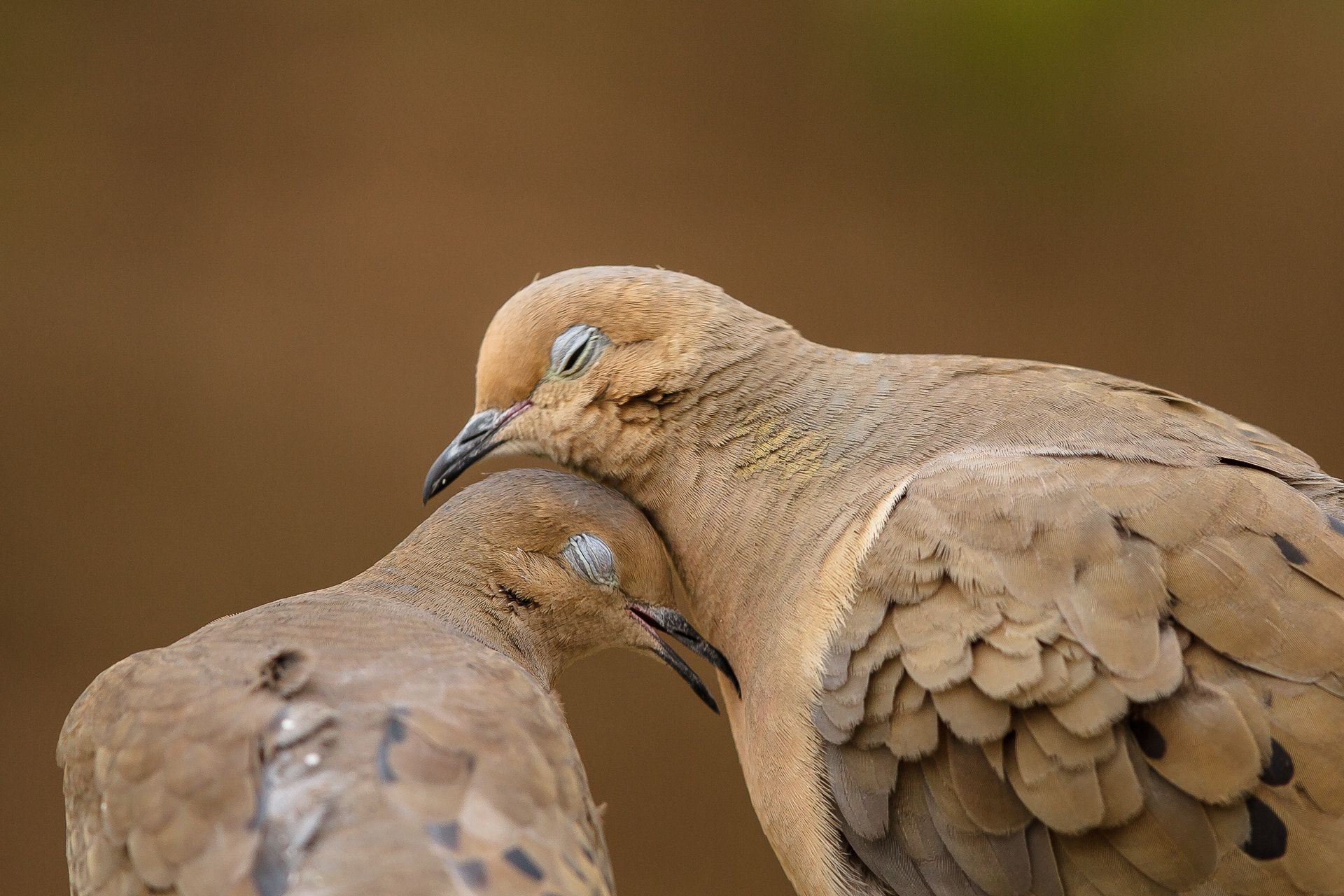
February 5, 2023
In the wintertime, the Creston valley offers open waters in Kootenay Lake and on the Kootenay River for the COMMON MERGANSERS! Look for the flash of white in the large drake who also has a bright orange bill and feet. The female sports a beautiful brown crest with a gray body. Courtship activities could be observed this time of year. Common Mergansers will dive underwater for a fish meal.
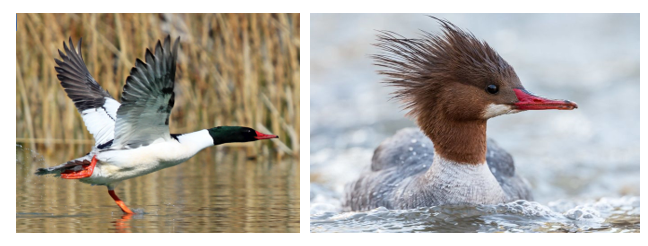
January 29, 2023
A COOPER’S HAWK is an accipiter that is in the same family as the smaller Sharp-shinned Hawk and the larger Northern Goshawk. It is very agile in pursuing small birds through trees and bushes. In the winter it will hunt near birdfeeders.
Look for the longer, rounded tail with dark bars and a broad white tip.

January 22, 2023
There were three RUFFED GROUSE spotted during the Creston Christmas Bird Count on December 27th. They can be found singly in mixed woods. throughout our valley and BC.
They have a distinctive dark tail-band, crested head, and bold, dark bars on their flanks.
In the spring, you can hear the male’s territorial drumming and possibly see them displaying their fanned tail and collared ruff. This time of year they are “budding” which is feeding on the buds of deciduous trees and shrubs (source from Linda Van Damme 2020).

January 15, 2023
Introducing our festival poster bird – a GOLDEN-CROWNED KINGLET!!
On the Christmas Bird Count day, December 27th, there were 9 of these tiny birds found! They are found in mixed woods but are particularly fond of conifers year-round. Their high-pitched vocalizations can be heard before they are seen.
January 8, 2023
During the Kuskanook Christmas Bird Count on January 3, 2023 – two GOLDEN EAGLES were sighted! One was sitting on a snag by the viewpoint at the north shore of Duck Lake, and the second eagle was seen soaring at the glass house.
This would be considered a very rare sighting for this time of year. Golden Eagles are mostly found in mountainous areas where they hunt mainly for mammalian prey whereas Bald Eagles are found near water where they rely on fish in the summer and coots on the lake in the winter.
Golden Eagles are very large and dark with a golden nape. Adults have feathered legs! They have long wings, their wingbeats relatively smooth and shallow, and they will soar with a slight dihedral (compared to a Bald Eagle that soars with wings nearly flat).
January 1, 2023
The 25th annual Creston Valley Christmas Bird Count was held on December 27th and 6 WINTER/PACIFIC WRENS were sighted!
They can be found in forests with dense undergrowth, ground litter, and shrubs. Wrens are small, brown, and very secretive. They will creep through vegetation often with their tails raised.
Photo credit: Tammy Bradford
December 25, 2022
In at the wintertime, the COMMON LOON is reliably seen at the south end of Kootenay Lake, but also along the main channel, or on the east branch of the Kootenay River (source from Linda Van Damme 2020).
December 18, 2022
Camouflage at its finest! With its cryptic colors and tree-hugging creeping motions, BROWN CREEPERS blend in well with the bark of large trees in a mature forest. Watch for movement on a tree – it will fly to the base of a tree and creep its way up! In the winter, it will visit your suet feeder.
There is always a high chance to see one during the Christmas Bird Count which is held in Creston on December 27th. If you are interested in participating, please contact info@cresonvalleybirds.ca. Birders are still needed in the Wynndel and Lakeview-Arrow Creek areas.
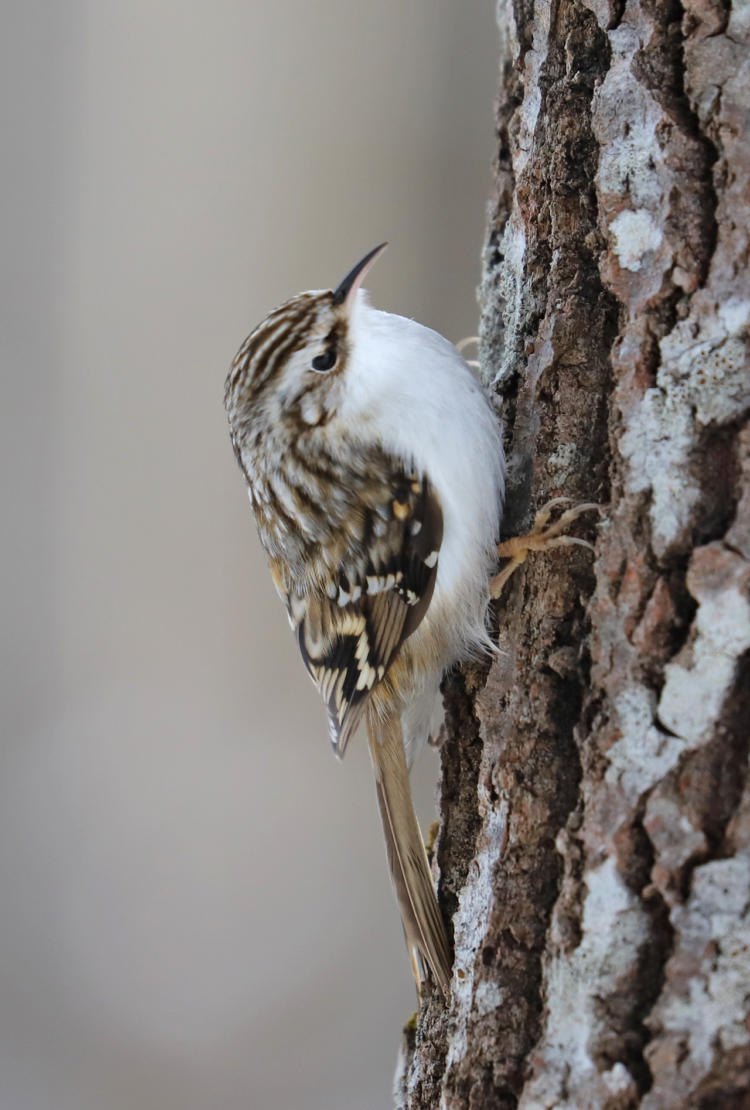
December 11, 2022
Two HORNED LARKS were spotted off Channel Road towards Duck Lake a few days ago!! Notice the dark mask and breast band as well as the “tiny horns”! In the wintertime, they can form large flocks and will mix in with longspurs and Snow Buntings. Although a rare sighting in Creston this time of year, they can be found in snowy fields with exposed grasses if you are lucky!!

December 4, 2022
Flocks of DARK-EYED JUNCOS showed up at my feeder yesterday! These winter birds are found in open woods and brushy clearings in our valley but are also regular visitors at feeding stations. This photo is showing an Oregon subspecies which is the most common.
If you have an active birdfeeder and would be interested in counting birds on DECEMBER 27th for the Audubon Annual Creston Christmas Bird count, please contact info@crestonvalleybirds.ca
For more info:
https://www.birdscanada.org/bird…/christmas-bird-count
November 20, 2022
A large migrating flock of AMERICAN TREE SPARROWS was seen on the Kootenay River Road yesterday. They can be seen throughout the winter along weedy roadsides.
This long-tailed sparrow has a very distinct dark breast spot. The crown is mostly rufous and there is a rufous eye-line.
November 13, 2022
The CACKLING GOOSE looks like a mini version of a Canada Goose (about 1/4 of its size – see comparison in below photo). Cackling Geese are more delicate, with stubbier bills, steeper foreheads, shorter necks, and usually more rounded heads.
Listen for the distinctively high-pitched “Cackling” call which is noticeably different from Canada Geese.
Like their larger relatives, Cackling Geese forage in marshes and fields in large flocks, often mixed with other goose species. A group was spotted yesterday flying over the Kootenay/Speers Roads with a flock of Canada Geese.
October 23, 2022
BC’s Provincial bird is very noisy and can be heard calling all around town. The STELLER’S JAY most common call is a very harsh, unmusical, descending “shaaaaaaar” that is also used to wake up sleepy humans when the tray of peanuts needs refilling! They can carry several peanuts at the same time and will “cache” them for the winter. They have an incredible memory and can locate the nuts months later.
October 16, 2022
A SURF SCOTER is a large sea duck that migrates in the autumn along the Pacific coast but is a very rare sighting within the interior (sourced by Linda Van Damme 2020). Four birds were seen at Duck Lake last week.
The square head and multicolored triangular bill are most obvious in the male who are almost entirely black with white patches on the forehead and the nape. Adult females are slightly smaller and browner. Surf scoters breed in Northern Canada and Alaska and winter along the Pacific and Atlantic coasts of North America.
October 9, 2022
Currently there are hundreds of CANADA GEESE and GREATER WHITE-FRONTED GEESE mingling together at the CVWMA.
The highest numbers of Greater White-fronted geese migrating from northern breeding grounds in the Yukon occur in the Creston valley of BC’s interior (sourced from Linda Van Damme 2020). They are using the wetland for feeding and resting before continuing their journey to northern California. They are fun to listen to with their high-pitched laughing!
Canada Geese are very vocal as they fly overhead in their converging lines. Not only do they migrate through our valley, but they also breed and over-winter here.

Photo credit: Ulrike Sliworsky
July 31, 2022
A very rare sighting of a PEREGRINE FALCON was recorded this week on the Kootenay/Speers Roads hunting in the open fields.
This falcon is a very fast flier, averaging 40-55 km/h in traveling flight, and reaching speeds up to 112 km/h in direct pursuit of prey. During its spectacular hunting stoop from heights of over 1 km, the peregrine may reach speeds of 320 km/h as it drops toward its prey. It is definitely a sight to see!!!
July 10, 2022
CEDAR WAXWINGS are enjoying a mosquito feast at Duck Lake right now! Watch for these smooth, sleek birds with warm brown colors and a yellowish belly. Insects become an important part of their diet during the breeding season. They are great aerial predators!
June 19, 2022
A plain brown bird with a very chatty voice, the HOUSE WREN is a common backyard bird over nearly the entire Western Hemisphere.
Listen for its long, rushed-and-jumbled song in summer. https://www.allaboutbirds.org/guide/House_Wren/sounds
Find this species zipping through shrubs and low tree branches, snatching at insects. House Wrens will gladly use nest boxes, old cans, boots, or boxes lying around in your garage.
June 13, 2022
A common sight at Duck Lake are flocks of RING-NECKED DUCKS. They don’t actually have a ring around their neck but a white outline on their bill helps to recognize the adult males. They have a distinctive peaked head, a white “spur” on breast sides, and a black back.
Large flocks of up to 1500 birds can be seen during migrations through our valley. This time of year watch for moulting males and females with their tiny ducklings!
Photo Credit: Ulrike Sliworsky
June 5, 2022
AMERICAN BITTERNS can mostly be heard in the wetlands within the CVWMA. These secretive, cryptically-colored herons have a deep, gulping “pump-er-lunk” sound that gets repeated often during dawn and dusk.
https://www.allaboutbirds.org/guide/American_Bittern/sounds
The loss of wetland habitats in British Columbia over the past two decades has made the Creston valley and its protected marshes a significant breeding area for American Bittern in the province (Linda Van Damme, 2020).
May 29, 2022
Beautiful male LAZULI BUNTINGS can be heard singing on their territories right now. This weekend, I saw 2 on the Devon Trail.
They prefer brushy patches and shrub thickets along forest edges, marshes, fence lines, roadsides, and transmission corridors (sourced by Linda Van Damme 2020).
The lively song is a high, sharp warble. The male is a small turquoise-blue finch with pale cinnamon across his breast and side and with 2 white wing bars.
May 22, 2022
BOBOLINKS are the latest of the songbirds to return in the spring to agricultural lands, especially hayfields on the flats (sourced from Linda Van Damme 2020). A few of them were seen this week near the potato farm on Reclamation Road.
Males have a cheerful and bubbling “bob-o-link” song given in flight. During breeding, they have a straw-colored nape with a white rump and scapulars.
During nesting, males become less conspicuous. Hayfields in Creston get mowed two or three times in the season which may impact nesting attempts.
Their southern migration begins early so they are not here in the valley very long! They travel about 20,000km round trip each year from the South America wintering grounds.
May 8, 2022
The warblers are back!!! YELLOW WARBLERS were sighted at Duck Lake. These beautiful yellow birds are the most common of our local nesting warblers. You can hear the males singing in the shrubs along the dike. Song is “sweet sweet sweet ti ti ti to soo”!!!
Note the bright yellow plumage with the males sporting reddish streaks on their chest.
May 1, 2022
A BROAD-WINGED HAWK was sighted recently in the Creston Valley. They are rare spring migrants that sometimes are not spotted as they fly really high! The wings are pale with a dark border. Tail has one white band in the adults.
April 24, 2022
This is a good time of year when the water levels in the Kootenay River are low to walk along the riverbank to look at the BANK SWALLOW holes! A few birds were sighted yesterday!
Overwintering in Panama, Argentina, and Chile – these swallows return at the end of April to early May to their former nesting sites (source from Linda Van Damme 2020).
Bank Swallows are brown with a white throat and belly that has a dark breastband. It has a long , notched tail and thin wings.
April 17, 2022
A LONG-BILLED CURLEW was sighted on Reclamation Road 2 days ago!! They feed on insects and earthworms in agricultural fields. Most records occur in West Creston (sourced from Linda Van Damme 2020).
This is our largest sandpiper and, as the name states, has an extremely long bill! It has a plain plumage but the cinnamon underwing when it flies is very striking. Flight calls are clear whistles with a sharp rise at the end. “cooooooLi”
Long-billed Curlews are designated by the federal “Species at Risk Act” as a Special Concern in BC and considered vulnerable. A province-wide survey is underway. If you see a bird, please send a message to info@crestonvalleybirds.ca
April 10, 2022
HOODED MERGANSERS are in the Creston Valley year-round but at this time of year, they are performing their courtship displays!! Pairs can be found in Duck Lake, in the channels along Channel Road, or in the Corn Creek marsh. For nesting, they will use natural crevices or excavated woodpecker cavities in black cottonwoods (Source from Linda Van Damme 2020).
Look for the unique “hammerhead” white crest on the male that looks spectacular when its raised! The female has a frosted brown crest. Males also show off two black spurs on their sides.
April 3, 2022
There have been 2 SANDHILL CRANES hanging around Duck Lake the last 2 weeks!! They are very noisy and conspicuous so you can’t miss them. Standing at almost 4 feet high with a rust-stained plumage and a red crown, these cranes pick food from the ground.
Although some might just be migrating through our valley, there are records of Sandhill Cranes breeding in the wetlands of the CVWMA (sourced from Linda Van Damme 2020).
March 27, 2022
The swans are back in our “Valley of the Swans”!!! I counted over 600 TRUMPETER and TUNDRA SWANS this week on Reclamation Road and Swan Road!!! The northbound passage is very short so this is the time to see them!
The Trumpeter Swan is larger overall with a longer neck and bill. They have a gentle nasal honking sounding very much like a trumpet.
Tundra Swans are smaller with a shorter neck. They have yellow lores on the bill. Their voice is more like a hoot or bark.
Photo: Lyle Grisedale
March 20, 2022
A regular spring migrant, the GREEN-WINGED TEAL can be seen throughout the Wildlife Management Area especially in the shallows of Duck Lake right now. They will continue to show up until mid-May. Preferring to breed further north, they are not common in the summer months.
This is our smallest dabbling duck! It has a dark rufous and green head with green on the wing, of course!
Photo: Joelle Burnie from our Friends of Kootenay Lake!
March 13, 2022
Another sound of spring is the haunting call of a VARIED THRUSH. Listen for a single, long whistle on one pitch which is repeated every 10 seconds. Each whistle is on a different pitch! I heard one calling on my walk around town this week.
More secretive than it’s close relative, the American Robin, it likes damp and shaded coniferous forests.
Varied Thrush are most notable during spring migration with first arrivals trickling in during the last week of February and first week of March. This highest number of spring records occurs in March (sourced from Linda Van Damme, 2020).
March 6, 2022
Are you hearing the “kon-ka-reeeeee” sounds of spring!??
Flocks of RED-WINGED BLACKBIRDS have returned to wet, brushy, marshy areas in our farmlands and suburbs!
Territorial males have started singing to attract numerous females. This large spring migration will continue until breeding season when the females build their nests in cattails.
February 27, 2022
Another pretty little winter bird is the COMMON REDPOLL. This bird breeds in the northern boreal and taiga forests of BC but when seed-crops fails, especially from birch, then the redpolls are forced south in the winter to search for food. This makes them an irruptive species which might not be present every year (sourced from Linda Van Damme 2020).
Watch for them feeding on western red cedar seeds, birch and alder catkins, picking grit from roadways, or hanging out at your feeders with the siskins and goldfinches!
Photo Credit: Patsy Duncan
February 20, 2022
GOLDENEYES winter in small flocks on ice-free lakes and rivers in our valley. This is when they form pair bonds.
The Barrow’s Goldeneye has a white crescent-shaped patch by the bill and the Common Goldeneye has a round-shaped patch. Barrow’s are very rare to uncommon in winter, whereas the Common Goldeneye are … very common! Hence the name!

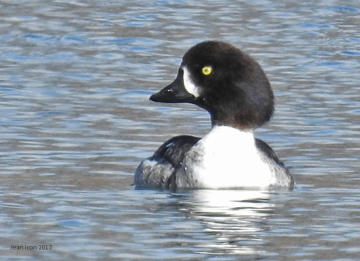
February 13, 2022
The dainty DOWNY WOODPECKER is our smallest woodpecker with a very short bill. It is distinguished by its white back. Downy Woodpeckers visit suet feeders in the wintertime.

February 6, 2022
Have you ever heard a loud nasally “ank ank ank” coming from a coniferous forest? It’s a tiny RED-BREASTED NUTHATCH!!
Nuthatches have a unique tree-climbing method where one foot is placed lower to act as a brace. The higher foot grips the bark. This enables them to climb head down a tree, feeding on insects gleaned from bark crevices. If you have a feeder near some woods, they will come visit for seed.
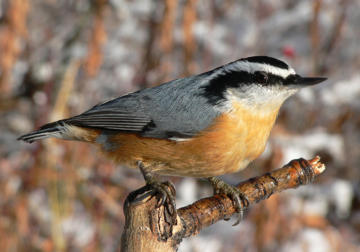
January 30, 2022
In the winter, PINE GROSBEAK males add some brilliant color to our foggy, grey days when it comes down from higher elevations to feed on berries in our valley.
Most sightings occur in winter when single birds or small flocks are found on Kootenay Pass, Kootenay Flats, and the bench lands. Less frequently, birds visit feeders and often obtain grit or salt from roadsides (Linda Van Damme, 2020).
This is a large bird with a long tail. Look for the 2 white wing-bars.
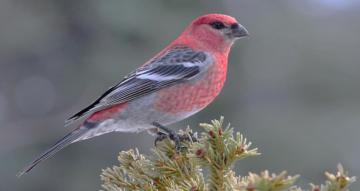
January 23, 2022
Another beautiful winter bird that visits our valley is the EVENING GROSBEAK. Look for the massive head and bill. White wing-patches and its bright yellow body are always conspicuous.
Because of their nomadic nature, the presence and number of these birds fluctuates each year. But when they do show up, they can be found throughout forested habitats from the valley bottom to subalpine areas. In residential areas you can see them where seeds and berry producing plants such as saskatoon, pin cherry, and chokecherry can be found (sourced by Linda Van Damme 2020). Flocks can be very noisy in treetops and bird feeders.
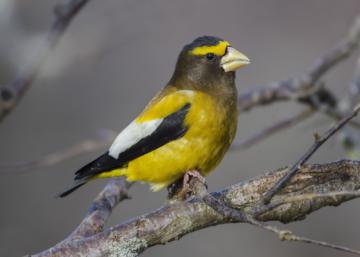
January 16, 2022
There are huge flocks (200+birds) of BOHEMIAN WAXWINGS flying around town right now.
These beautiful birds with their sleek plumage, crested heads, and yellow-tipped tails can be seen eating mountain ash berries and can be heard by their constant, high-pitched calls.
Bohemian Waxwings are not around in the summer as they head north to breeding grounds so enjoy them now!!!
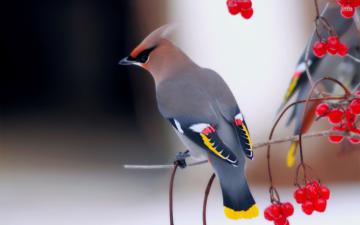
January 9, 2022
Although the Anna’s Hummingbird stole the show at this year’s Creston Christmas Bird Count, another very rare species found in the winter here is a RUSTY BLACKBIRD!! One bird was sighted on the Kootenay-Speers Road to make this the first bird in 24 years of counting on December 27th to make an appearance!!
This bird likes to go solo and could easily go undetected in large flocks of other blackbirds and starlings that frequent beef and dairy farms (sourced from Van Damme 2020).
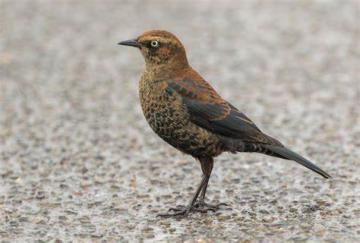
January 2, 2022
ANNA’S HUMMINGBIRDS don’t migrate to warmer climates! They are a common year-round resident on Vancouver Island, the Lower Mainland, and the Sunshine Coast but they have been expanding their range to the southern interior – including Creston!! 4 birds were sighted on this year’s Christmas Bird Count at artificial feeders around town.
According to the Royal Society Journal and 17 years of data from the Project Feederwatch program, Anna’s have colonized colder locations over time. The winter range expansion is due to changes in climate, urbanization, and supplementary feeding which reduces their tendencies to migrate. This is a good example of how humans can alter the distribution of species and their migratory behaviors.
Other reasons why Anna’s might be staying in our cold town lately would be that they are lost! They can be pushed from their migratory routes due to storms. 2021 was a year of heat waves, fires, and floods. Some younger birds could get trapped in winter areas due to inexperience.
So if you have an Anna’s Hummingbird at your feeder during this cold spell, please make sure they get their reliable daily food. The magic potion is 1 cup of refined white sugar to 4 cups of hot water. Never use honey, brown sugar, icing sugar, juice, artificial sweetener, or food coloring as this could be toxic to the hummers. Make sure the feeders get cleaned regularly. Use 2 feeders to swap them when cleaning and replenishing. Place them in a protected place for a wind break. If close to a window, the feeders would get heat from the house. Decorate with a string of lights to generate warmth (glass feeders only).
Anna’s can go into a mini hibernation or torpor at night to consume less energy. But on a sunny afternoon, watch them buzzing around town!!
Photo Credit: Eloise Carr
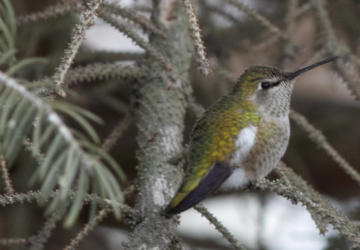
December 26, 2021
A GRAY PARTRIDGE was last seen during a Christmas Bird Count, December 27th 2012, in a snow-covered field in West Creston. These birds were extirpated before 1966 and probably immigrated from Idaho (sourced from Linda Van Damme 2020). Let’s try to find one again!!
Tomorrow, December 27th, is the 23rd annual Creston Christmas Bird Count Day! Hosted locally by the Creston Bird Festival Committee, and coordinated globally by Bird Studies Canada and the National Audubon Society.
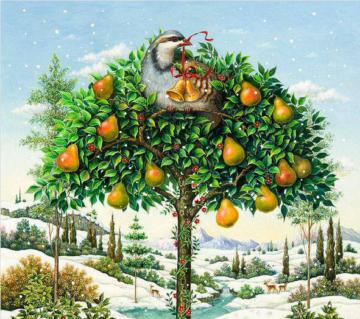

December 19, 2021
AMERICAN CROWS can be found and heard everywhere! There is a “murder ” of about 50+ crows around Erickson Elementary School everyday when I go to work. They are widely distributed especially near human habitation so they are very hard to miss. Crows are around throughout the year and can be pests in fruit orchards and crop fields (sourced from Linda Van Damme 2020). They can also be found at most road-killed carcasses, cattle feedlots, woodlands, and marshes.
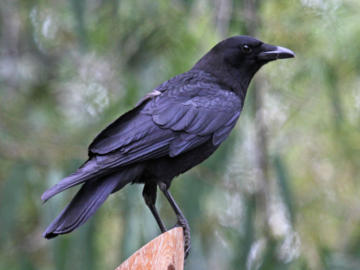
December 12, 2021
RUDDY DUCKS are ‘stifftails’ that have a long tail which is often raised.
During the breeding seasons, the males sport a beautiful blue bill! In the winter watch for the big head with a dark cap and white cheeks.
Ruddys are found in open waters, often in tight flocks. There were some out at Duck Lake recently. They should be continuing southward soon as they do not overwinter here.
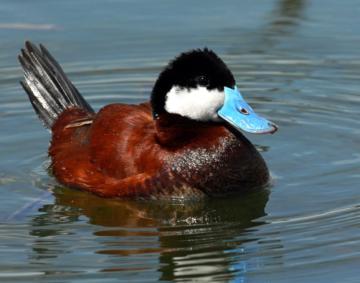
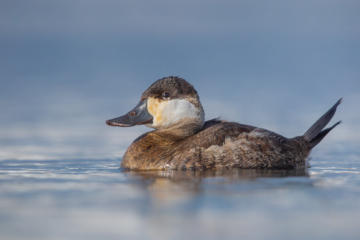
December 5, 2021
BLUE JAYS can be seen and heard in either urban or rural environments.
Most observations of this species is in the autumn and winter when flocks move around neighborhoods visiting feeding stations
especially those stocked with unshelled peanuts (source from Linda Van Damme 2020).
They are usually sighted on Christmas Birds Counts which are held on December 27th in Creston every year.
Jays are very noisy with a shrill, harsh, descending scream as if saying “jaaaaaay”!!
Watch for the flashing white tail and wing patches as it flies away. It has a pretty pale blue color with a black ‘necklace”.
Photo Credit: Lyle Grisdale

November 28, 2021
Every now and then a casual, accidental, introduced, and extirpated species shows up unexpectedly in the Creston Valley!
Sachi Snively reported a SWAMP SPARROW sighting on eBirds for November 27th, 2021 at Duck Lake. To confirm this sighting, he included a photo and an audio of this bird. He description says “non-breeding adult with rufous wings, tail, and crown. Grey supercilium and side of nape”. It was found hanging out with Song and American Tree Sparrows.
eBird is an online database of bird observations providing scientists, researchers and amateur naturalists with data about bird distribution and abundance. It is a great tool for birders to keep a ‘life list’ of their bird sightings, and to share their sightings with other birders.
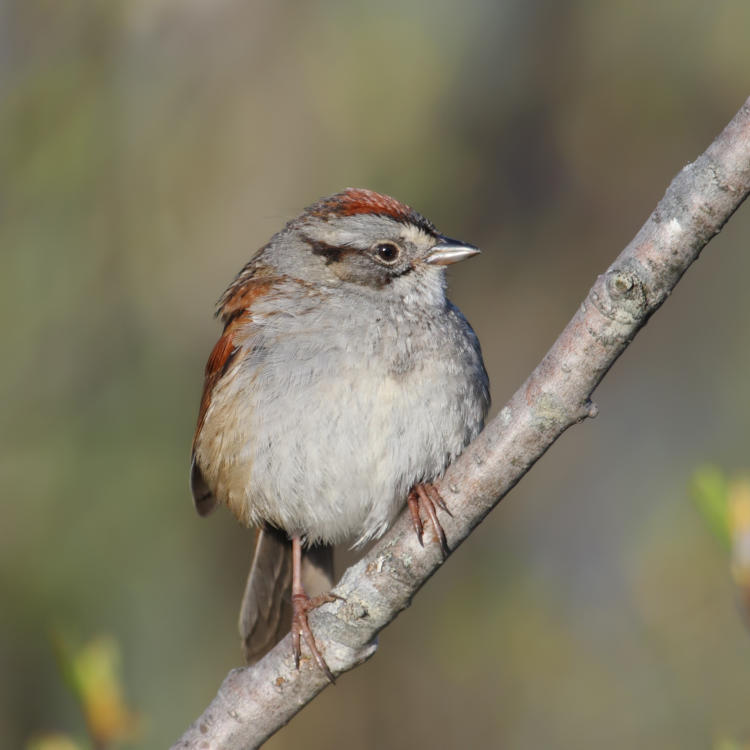
November 21, 2021
AMERICAN DIPPERS are usually found in very cold, fast-flowing, rocky streams but this one was seen
last week walking on ice in the West Creston channels (photo credit: Darlene McDowell).
This stocky, short-tailed bird is unique as it’s the only songbird that regularly goes for a swim!
It has transparent eyelids to see the aquatic insect larvae underwater (sourced from Van Damme 2020).
American Dippers are seen in Creston year-round and have been recorded in most Christmas Bird Count days.
Look for them along the ice-free shorelines of Kootenay Lake and the Kootenay River.
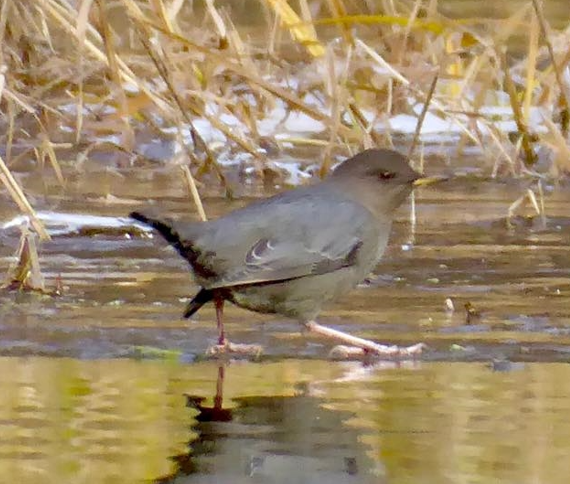
November 14, 2021
RING-NECKED PHEASANTS can be found in open fields and along weedy forest edges. My dog, Dixon, flushed 4 of them feeding on dropped plums on the Devon trail the other morning!
They can be heard more than seen with the males giving loud, harsh, hacking calls followed by a short burst of noisy wingbeats. This can be heard year-round but in the springtime more frequent.
Widely introduced from Eurasia, with our local Creston Valley birds being introduced in 1912 when Dr. Henderson received a shipment of birds from an Okanagan hatchery. He was an avid hunter and Creston’s first doctor! (sourced from Van Damme 2020)
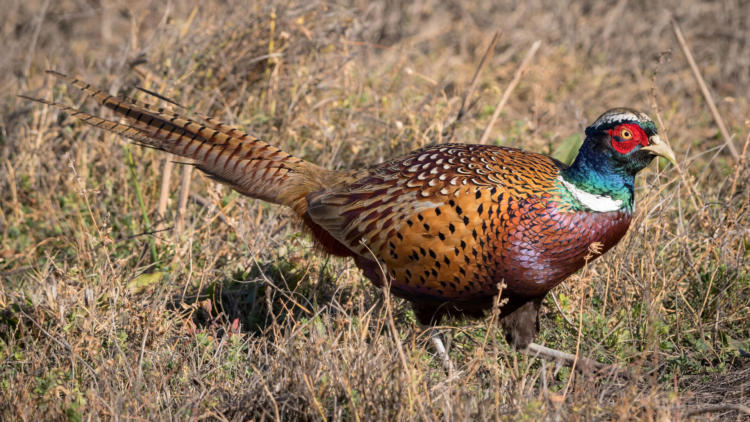
November 7, 2021
SNOW BUNTINGS have been spotted lately at Duck Lake! They are mostly found in flocks on open ground looking for seeds.
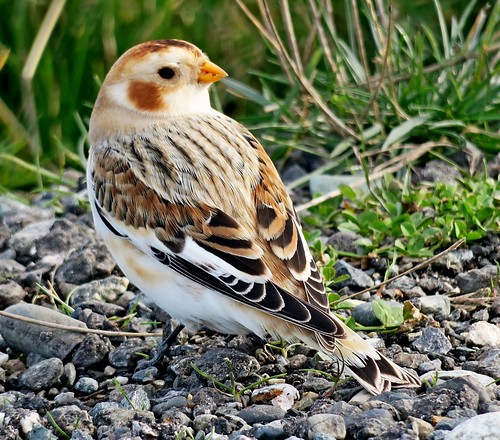
October 17, 2021
AMERICAN PIPITS are common autumn transients passing through the Creston Valley this time of year, and can be found feeding in large flocks on the farm fields.
A flock of 30 birds was seen on Reclamation Road this week. A slender bird with long legs that walks upright and can be distinguished by its bobbing tail!
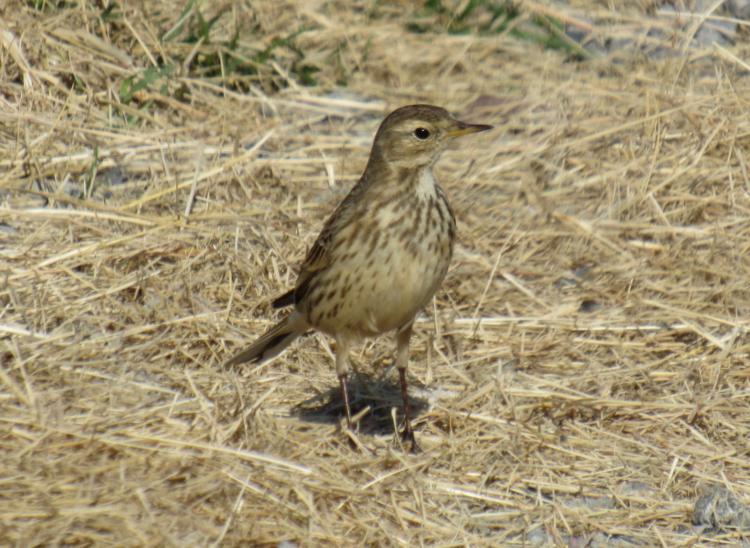
October 10, 2021
NORTHERN HARRIERS can be found flying low over hayfields and pastures where they hunt for Meadow Voles.
A favorite hunting location is at Duck Lake. Look for them perched on the ground or on fenceposts.
The white rump is always obvious.
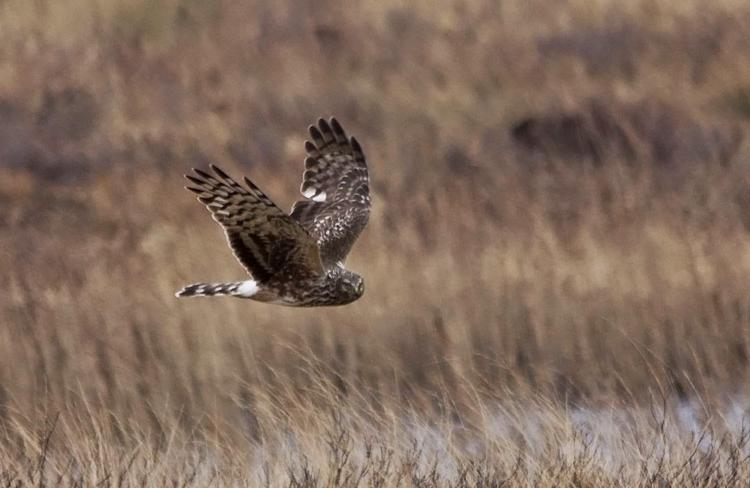
October 2, 2021:
AMERICAN WHITE PELICANS are moving through the valley right now.
You can find them at Duck Lake, Leach Lake, and the Wildlife Centre.
They are always white with black flight feathers and a yellow-orange bill.
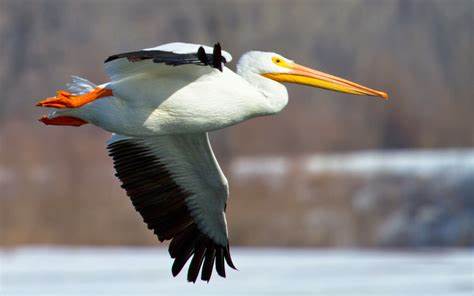
September 2021:
Duck Lake has thousands of AMERICAN COOTS! They are feeding on the water’s surface or diving for aquatic plants.
Other migrant waterfowl are mixed in with these large flocks!

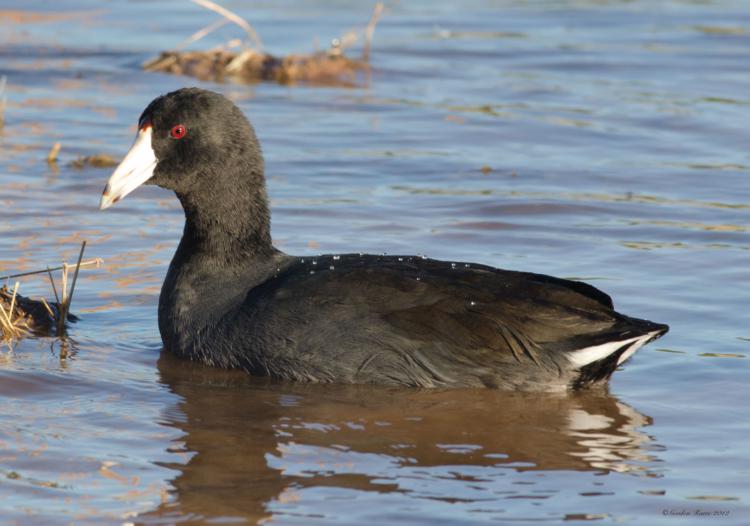
May 31: Red-eyed Vireos can be found in broadleaf forests such as at Summit Creek – a great birding hotspot in the Creston Valley.
Since they are mostly camouflaged in the foliage, they are best found by their loud song which is a hurried phase sounding as if they are saying-
“here-I-am, in-the-tree, look-up, at-the-top”!!! June and July is their breeding season so they will be singing in the forests the next couple of months!
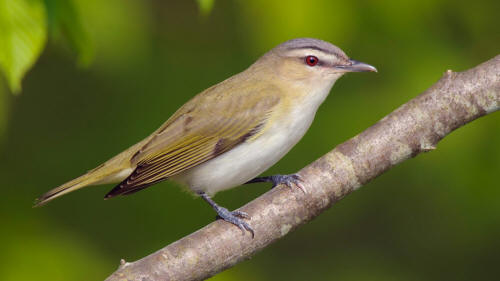
May 24: The Yellow-rumped Warbler is the most visible and most numerous wood warbler found in open woods and brushy areas.
It often perches upright on twigs with its yellow rump exposed, flitting up to catch flying insects.
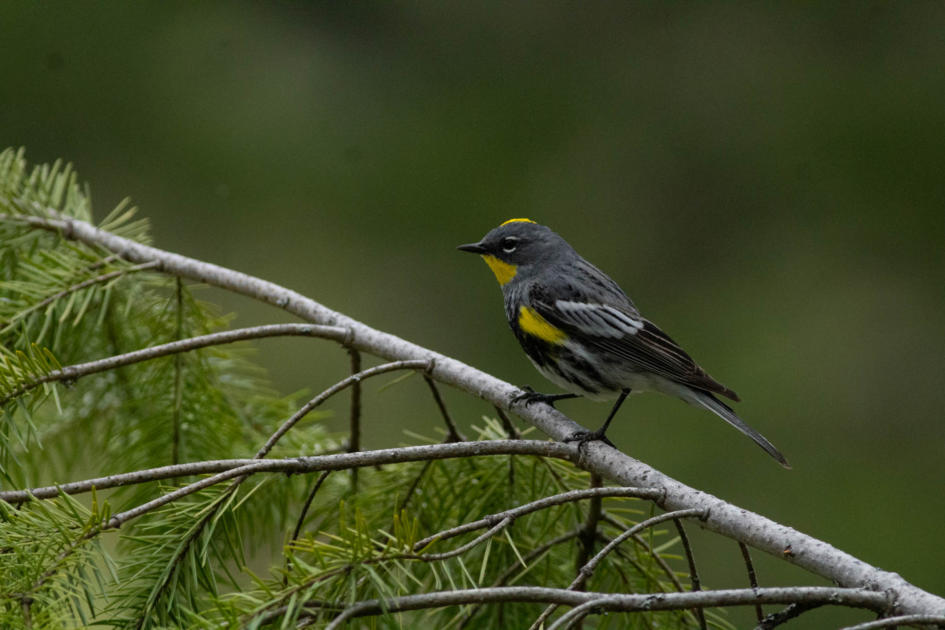
May 17: A pair of beautiful and very rare White-faced Ibises have been wading in the shallow waters of Duck Lake! Last year, 16 adults showed up for our Bird Festival! These birds stand 23″ tall, with a white border around a reddish face and eye, glossy green and red body, long gray bill, and red legs.
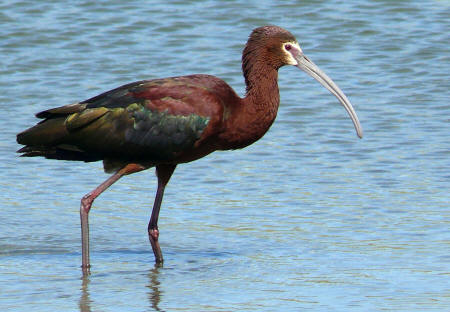
May 10: My favorite “festival find” this weekend was a flock of 30 Long-billed Dowitchers that were feeding in the south mudflats of Duck Lake. What an amazing time to see shorebirds out there! They are all just passing through so make sure you get out there soon to see all these spring migrants.
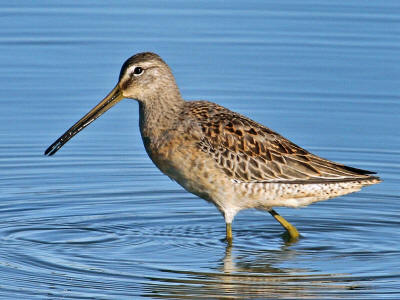
May 3: Belted Kingfishers can be found along the Kootenay River, in the channels, lakes, and marshes. It likes to perch near the water on branches, wires, or poles where it looks for its aquatic prey. They catch their fish by plunge-diving head-first! Sometimes you can hear it’s harsh rattling call before seeing the bird. It nest in holes excavated in dirt banks.
Photo Credit: Darlene McDowell
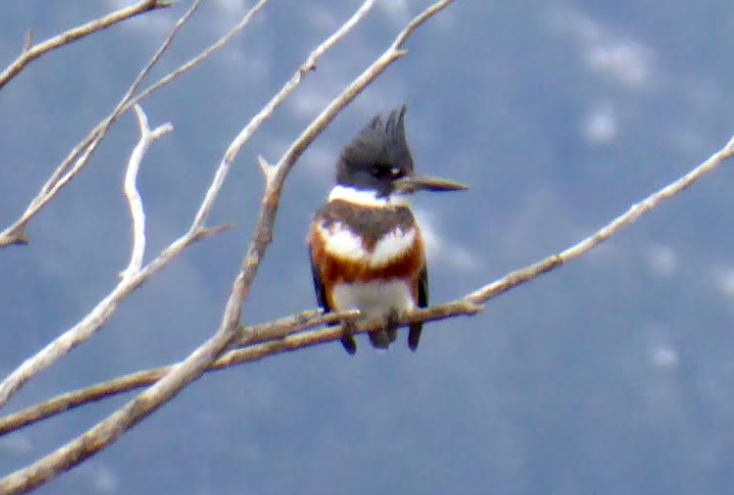
April 26: There have been 9 elegant Black-necked Stilts hanging around the south, shallow shores of Duck Lake these last few days to start off the annual shorebird migration! This striking species is very tall and slender with a black and white plumage and long red legs.
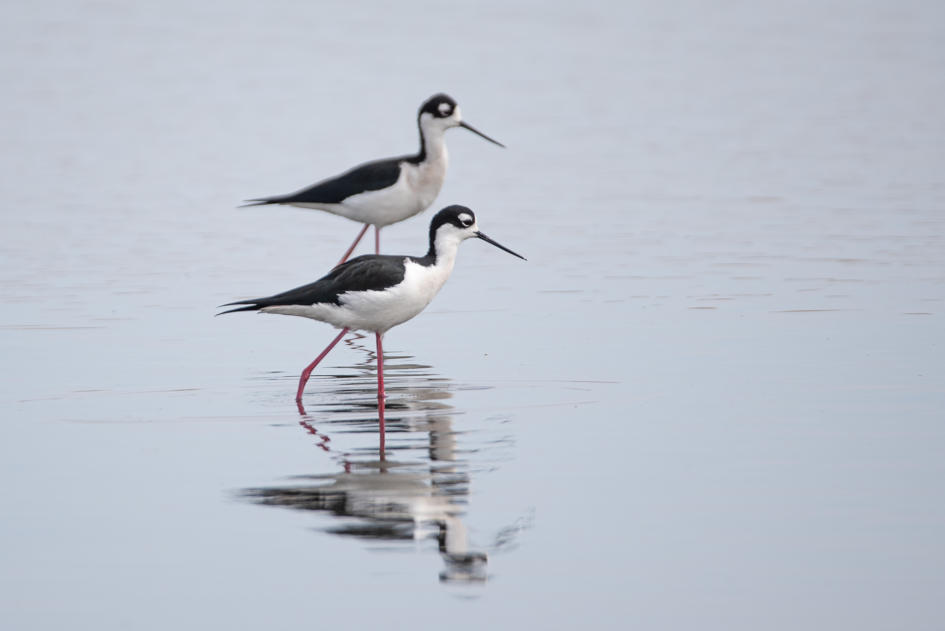
April 19: First babies of the year – Great Horned Owl owlets are peeking out of the nest! Territorial hooting begins early, and from late December through March, the males proclaim a territory and attract a mate (sometimes it is a renewed interest!). Courtship vocalization is then heard with bouts of “duetting” or “bill-snapping.” Owls do not build their own nests. Live and dead cottonwood trees with natural hollows are common nesting sites. You can also find them in stick nests made by Red-tailed Hawks, Crows, and Ravens, or on clumps of parasitic mistletoe growing on western larch trees. Fledged owlets will stay with their parents all summer to beg for food. Hunting is from perches bordering open habitats. Sometimes they can be found roosting in farm buildings. (Sourced from Van Damme 2020). Fledged owlets will stay with their parents all summer to beg for food. Hunting is from perches bordering open habitats. Sometimes they can be found roosting in farm buildings.
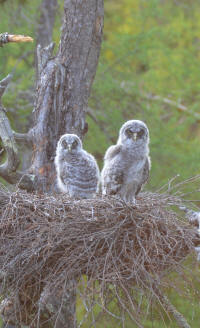
April 12: Mountain Bluebirds are moving through our valley bottoms. My friend saw 6 of them together on Uri Road, and I sighted 3 yesterday at Baillie-Grohman winery. They seem to like the fence posts on route to the old ferry landing. There were close to 50 of them there last year!
Mountain Bluebirds nest in natural cavities and woodpecker holes but also like nest boxes which can be seen on fence posts. Putting up a nest box is a great way to keep them on your property to watch them feed the nestlings!

April 5: The Greater White-fronted Geese are passing through the valley on their way to the Yukon breeding grounds! Corn Creek Marsh is the best place to look for them. With the Kootenay River so low, also look along the exposed sandbars.
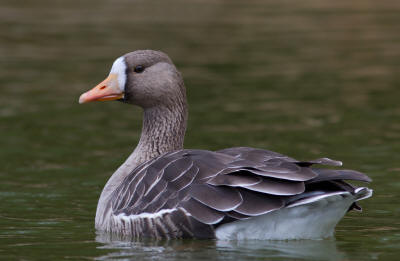
March 29: American Wigeons are very abundant right now in the nutrient-rich waters of Duck Lake and throughout the CVWMA.
Once considered a rare species in BC, the Eurasian Wigeon is now fairly common during the northward migration, according to Linda Van Damme. The first occurrence was in 1976 at Duck Lake with sporadic sightings after that. Since 1996 they have been recorded each year. Currently, there are a few mingling with the America Wigeons in the Corn Creek Marsh with even an American x Eurasian hybrid sighted by Marc-Andre Beaucher.

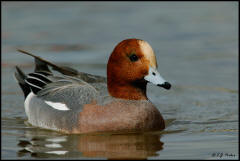
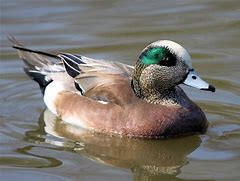
March 22: Northern Pintails are migrating through the valley right now and there are thousands to be seen at Duck Lake! This species can also be seen on flooded agricultural fields on the Kootenay Flats along with migrant Mallards and American Wigeons. The Wildlife Management Area is a significant staging and migration corridor during this spring passage.
Northern Pintails are a very slender and elegant dabbling duck that prefer shallow waters. It has long, narrow wings, long neck with a white stripe, and a long pointed tail.
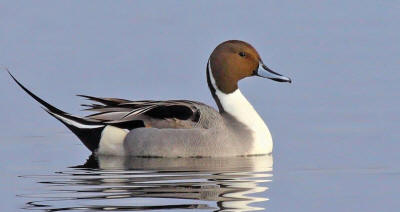
March 15: The Western Meadowlark can be heard singing from fence posts near open, grassy habitats. I heard the rich, musical, flute-like song last week on the Kootenay-River Road. The sounds of spring!!
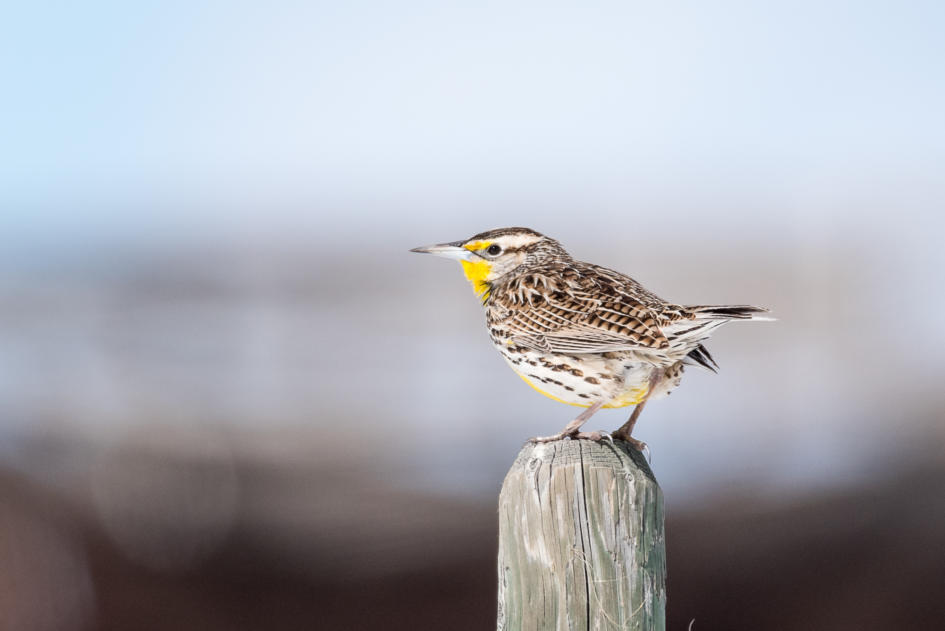
March 8: Spotted Towhees have started to return from their winter vacation and enjoying Creston’s warm weather! These birds are common in drier parts of the valley where there are shrub thickets. Preference to ocean spray, ninebark, mock-orange, saskatoon, snowberry, and wild rose (Linda Van Damme). Towhees are ground-dwelling and will scratch noisily through dead leaves but are sometimes difficult to see. They also enjoy visiting feeders and bird baths. Look for the long tail, dark head, white spots on wings, rufous flanks, and red eyes.

March 1: Wild Turkeys likely showed up in the Creston Valley during the 60’s after they crossed the international border from Washington. They are actually domesticated birds native to the New World.
Flocks can be found throughout most of the valley including within the townsite where they have become a nuisance by damaging gardens, yards, and birdfeeders. They favor open forests, agricultural fields, cattle pens and pastures, and rural properties near wooded areas.
The males will show off their elaborate courtship displays soon (mid-March). Like a peacock, they have a fan-like fancy tail, a bright facial wattle, iridescent plumage, and an exquisite dance.

February 22: Ever wonder what makes those huge rectangular holes in the trees around Creston? Pileated Woodpeckers are found near mature cottonwoods around the Kootenay River, Goat River, Boundary Creek, and Summit Creek. This species prefers the older or dying trees for foraging, roosting, and nesting. In the winter these birds are attracted to suet feeders in town, fruit trees (especially apple), and grapes.
Our largest woodpecker, this spectacular crow-sized species has a prominent red crest with a black back, broad black and white wings, and a long tail.
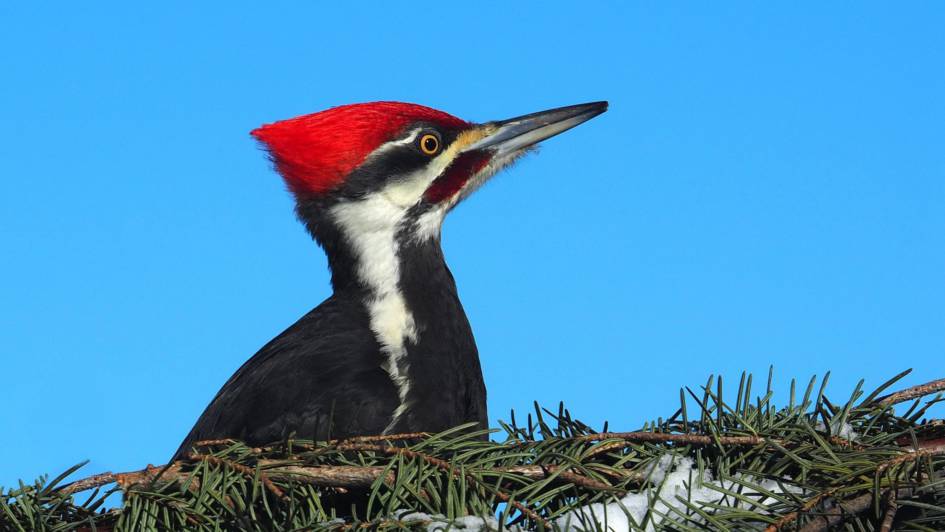


February 15: American Goldfinch are common visitors in the winter especially at feeders. They are present year-round with flocks forming after the breeding season and remaining intact throughout the winter. Flocks of up to 200 birds have been seen.
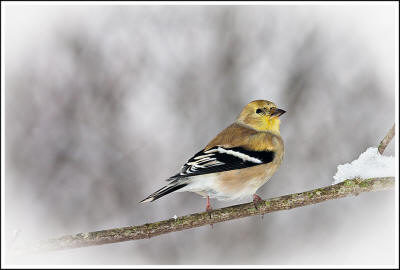
February 8: There are numerous Northern Pygmy Owls in the Creston Valley right now! During the winter months, these owls move from forested mountainous slopes to lower elevations where they become more conspicuous, especially because they are diurnal hunters. Watch for them perched on utility wires and poles, in cottonwoods, or on a snag. They could be found near bird-feeding stations hunting prey, or in hay sheds hunting mice.
At the moment, they are vocalizing. Listen for monotonous repeated single or double toots.
It is a small, compact owl (6.75″ in length) with a relatively long tail which is often jerked sideways and short wings. The white throat is obvious on a calling bird. On the back of its head are false eye-spots. The belly has narrow blackish streaks.

February 1: Merlins can be found in the Creston Valley’s residential areas where there are mature conifers and deciduous woodlands. Recently, Karen Douville has seen one near the Forest Lawn Cemetery in Erickson. According to Linda Van Damme’s new book “A Passion for Birds – their life in the Creston Valley”, Merlins will hunt near open fields and can be seen pursuing avian prey such as Eurasian-Collared Doves, Flickers, Robins, House Finch, and Bohemian Waxwings. These falcons are small, compact, powerful, and very aggressive! Look for the dark tail-band and “moustache”.

January 25: A Townsend’s Solitaire can be seen feeding on berries along the Devon Trail in town. This medium-sized thrush (same family as bluebirds and robins) is very dull gray but has a distinctive white eye-ring, buffy wing stripes, and white edges on the tail feathers which are evident in flight. They like to perch upright atop trees and shrubs to advertise their territories and often sit motionless for a long time. Although fairly inconspicuous, their sweet jumbling song is often the best way to track them.
This is the only Solitaire found in Canada.

January 18: The bold and inquisitive Black-Capped Chickadee is the most common species seen as well as heard around town and in birdfeeders. But also look in the woods for the Mountain Chickadee and the Chestnut-backed Chickadee!
Mountain Chickadees have a white supercilium above their eyes with a similar song to the Black-capped but with 3-6 syllables. The “chika dzee dzee” notes are slightly harsher, slower, and often descending. Chestnut-backed Chickadees love coniferous forests and mixed woods. It is our smallest chickadee with a unique dark chestnut back. Calls are generally higher with buzzy notes.
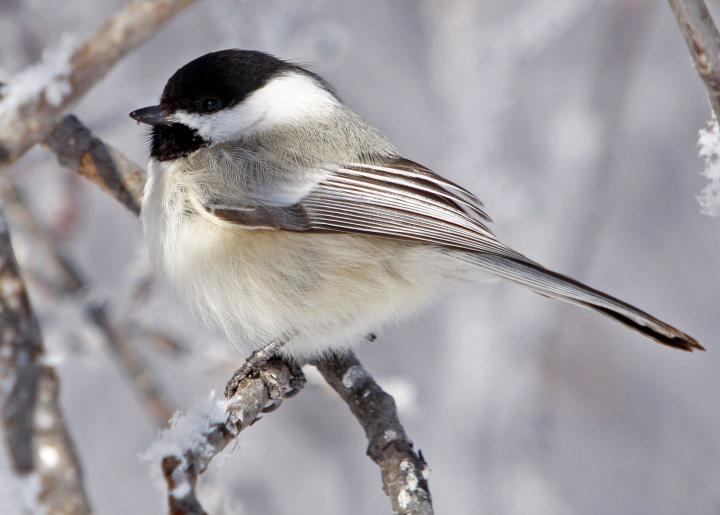
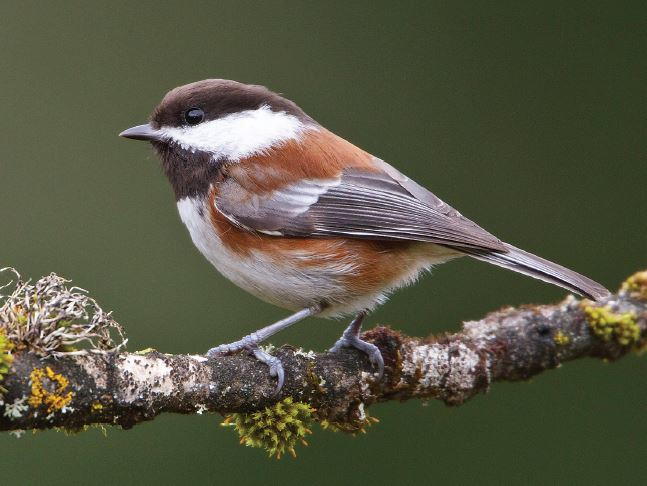

January 11: Crossbills are found in single-species flocks wandering erratically in search of food, mainly the cones of pines, spruces, and firs. Seeds are pried out using the unique crossed bill tip! White-winged Crossbills have been sighted on the Lakeview Arrow Creek Road. They prefer smaller cones mainly larch, hemlock, and spruce. Red Crossbills have been sighted in the forests of Lister, Erickson, and West Creston.
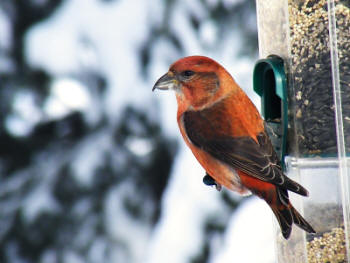
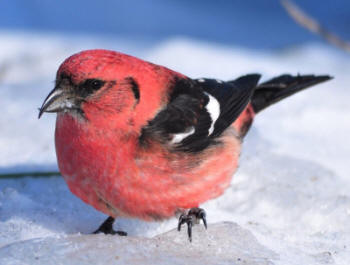
January 4: There are 4 species of Grebes on Kootenay Lake this week:
Pied-Billed: smallest, thick bill, dark eye
Horned: flat-topped head, white neck, red eye
Red-Necked: stocky, heavy bill, thick neck, dark eye
Western: largest, slender with long neck, red eye .

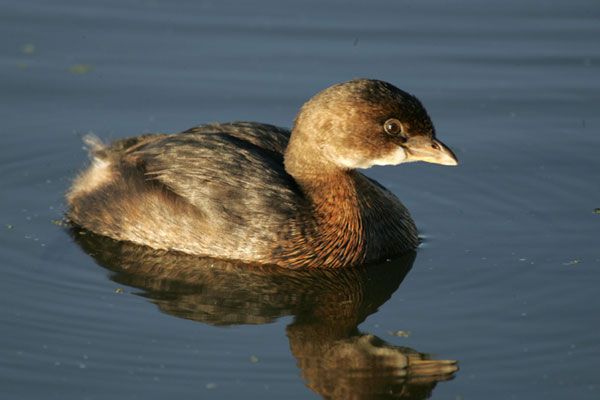

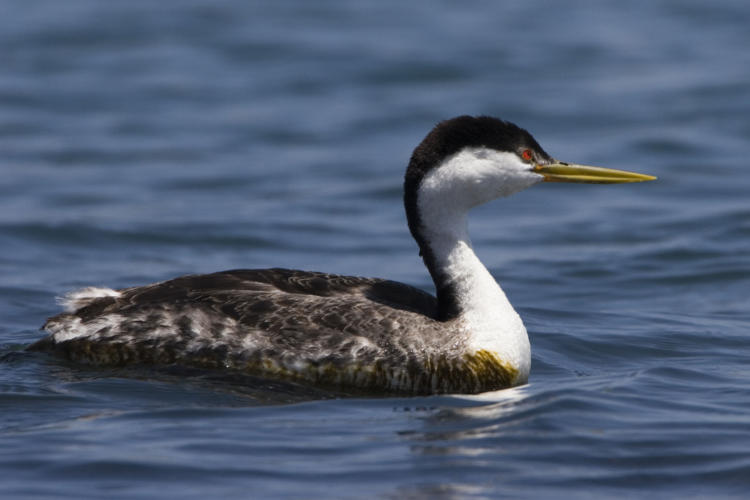
December 28: Northern Shrikes are being spotted throughout the valley.
Photo taken at Leach Lake by Marc-Andre Beaucher during the Christmas Bird Count on December 27th. But they have also been seen in Canyon, Duck Lake, Wynndel Flats, and West Creston Flats

December 21: Goat River Road S. to find California Quail.
This is also a good road to view Christmas lights in the evening. Merry Christmas Everyone – stay safe, healthy, and happy.
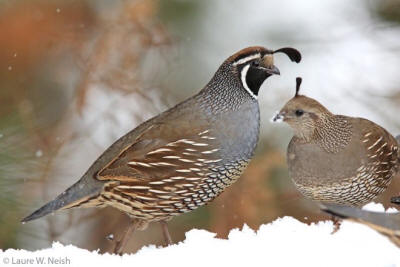
December 14: “Hawksview” aka. Kootenay-River Road where you can find Rough-legged Hawks and Red-tailed Hawks!
What to look for: RLHA will have a distinctive pattern of dark wrists and the primaries are always clean white. RTHA adults have the distinctive red tail and a streaked belly-band.
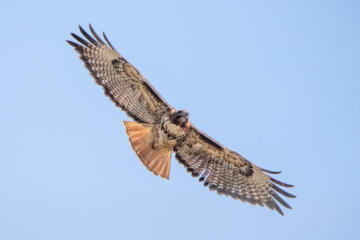

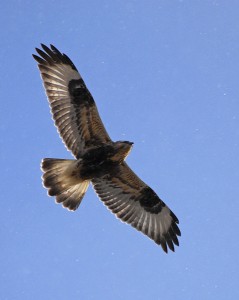
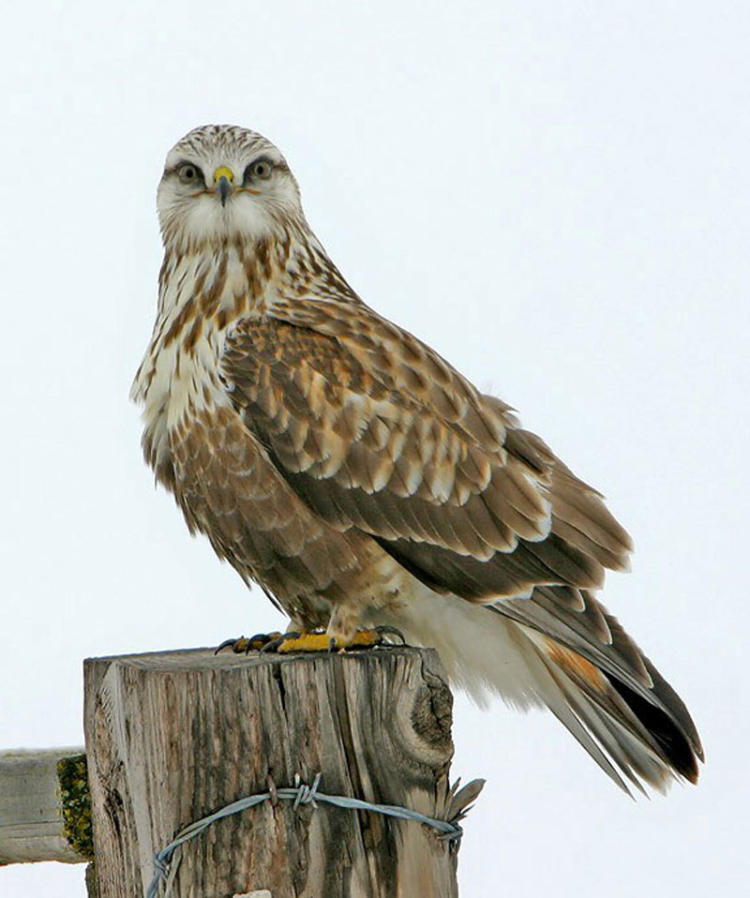
December 7, 2020: The Great-Blue Herons are once again skating and ice-fishing on Duck Lake!
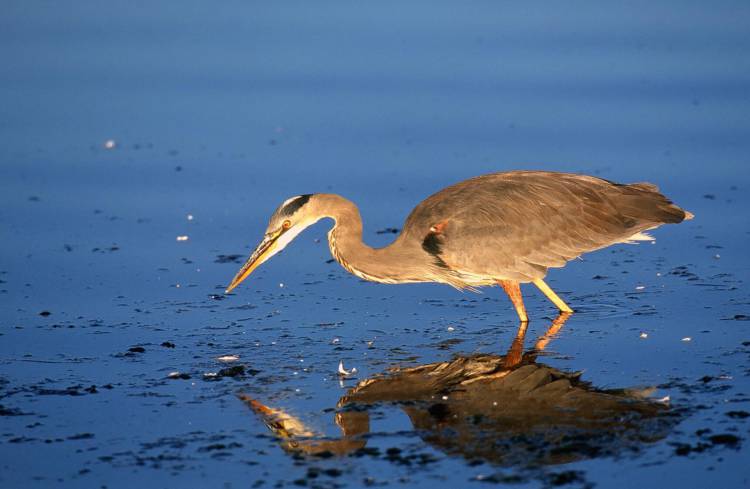
November 29, 2020: Iceland Gull at Kuskanook Harbour. Rare bird alert!!!
What to look for: overall light gray, darker patch on face, all black bill (for a first year), upper flight feathers brownish and darker on mantle.

November 23, 2020: The Short-Eared Owls returned to Duck Lake.





